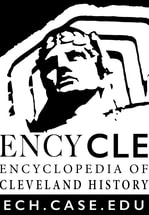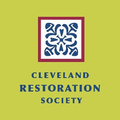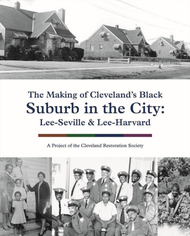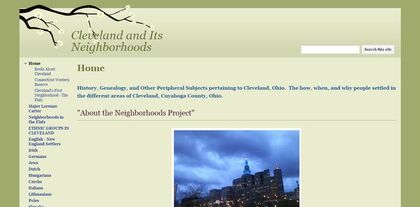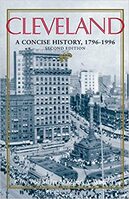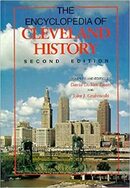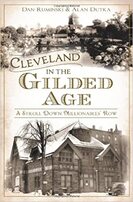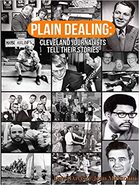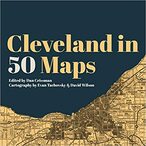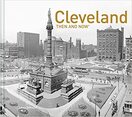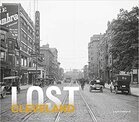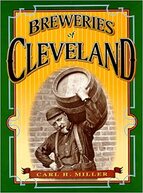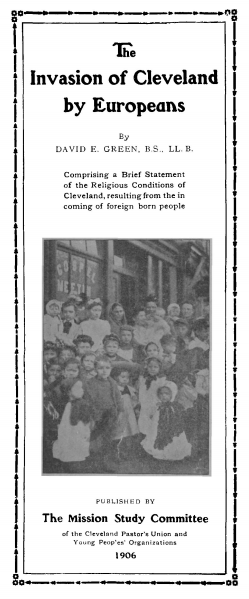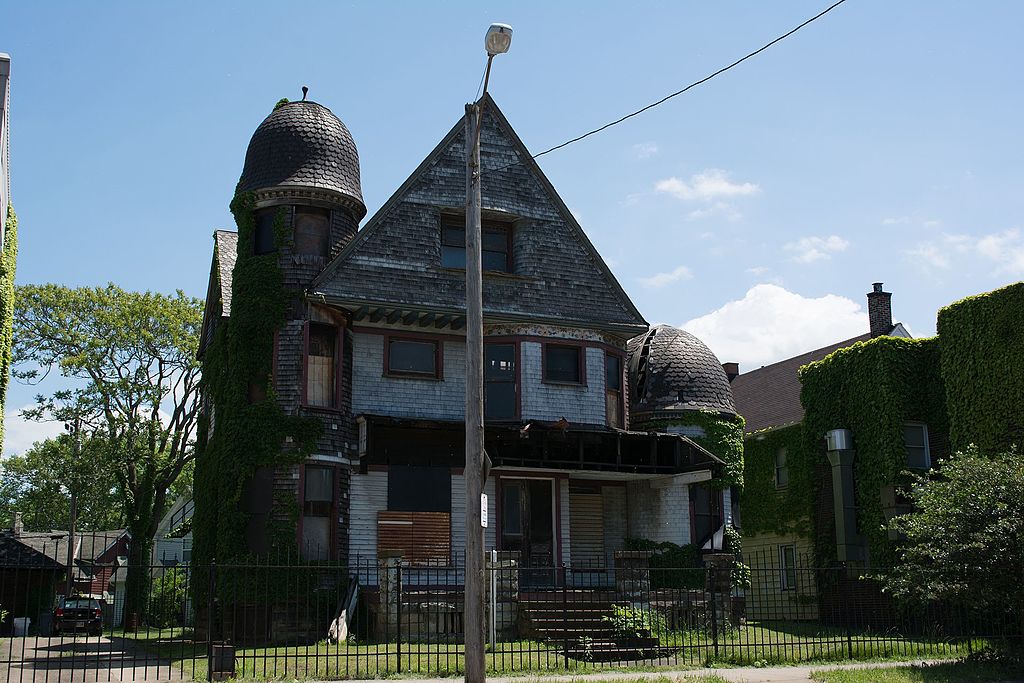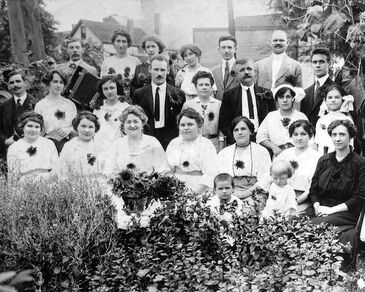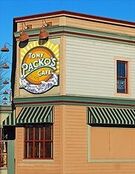Ethnic Cleveland
Northeast Ohio (NEO)
Immigration & Migration
Encyclopedia of Cleveland History
John Grabowski - A New Future for the Past: The Encyclopedia of Cleveland HistoryJohn Grabowski "A New Future for the Past: The Encyclopedia of Cleveland History" A Baker-Nord Faculty Work in Progress
|
Originating in the Case Western Reserve University's Department of History, the Encyclopedia of Cleveland History represents the contributions of hundreds of academic scholars and talented amateur historians to the interpretation and understanding of the history of Greater Cleveland. Its two printed editions (1987 and 1996) and its on-going World Wide Web edition are acknowledged landmarks in the presentation of urban history. Used as a reference by scholars, students, and interested citizens across the globe, the Encyclopedia has brought notice and credit to the city of Cleveland, Case Western Reserve University, and the Western Reserve Historical Society.
|
Cleveland Memory Project

In brief, the Cleveland Memory Project, launched in 2002, is a freely searchable online collection of digital photos, texts, oral histories, videos and other local history resources, built by the Michael Schwartz Library at the Cleveland State University in collaboration with a host of community partners around Northeast Ohio.
More specifically:
Cleveland Memory is an engaging look at Cleveland History —Here serious researchers and casual browsers will find tens of thousands of historical photographs, as well as a growing collection of eBooks documenting the history of greater Cleveland and the Western Reserve region of northeastern Ohio, its industries and its people.
Rounding out this landscape of Cleveland's past is an expanding selection of vintage video and sound recordings. And all of this is delivered to you in a searchable, database that is constantly updated.
Explore Cleveland history through images and words.
More specifically:
Cleveland Memory is an engaging look at Cleveland History —Here serious researchers and casual browsers will find tens of thousands of historical photographs, as well as a growing collection of eBooks documenting the history of greater Cleveland and the Western Reserve region of northeastern Ohio, its industries and its people.
Rounding out this landscape of Cleveland's past is an expanding selection of vintage video and sound recordings. And all of this is delivered to you in a searchable, database that is constantly updated.
Explore Cleveland history through images and words.
The Cleveland Memory Project — Northeast Ohio TimesNortheast Ohio Times offers you an interesting look at our region's special people and places. In this segment we visit Cleveland State University Librarian Bill Barrow. He talks about the Cleveland Memory Project that he founded. Its online site, http://www.clevelandmemory.org, includes images, manuscripts, texts, histories and e-books from the Special Collections of Cleveland State University. Produced in 2006.
|
Browse Our Web Exhibits by Topic
Our "Web Exhibits," which cover a wide variety of local topics, bring together all the digital resources available in Cleveland Memory (photos, eBooks, streaming video, etc.) with background information to provide visitors with a better understanding of how these artifacts of our collective past bring meaning to our lives today. |
Cleveland Restoration Society
Cleveland and Its Neighborhoods
|
For those interested in genealogy research, see my sister site that will tell you just how to go about it: https://sites.google.com/site/faqcuyahogactyresearch/home
|
"About the Neighborhoods Project"
Our main goal is to show the genealogy of the neighborhoods of the Greater Cleveland area. We will show the how, when and why people settled in the different areas, and then their migration to other parts of Greater Cleveland, Cuyahoga County (or beyond). The evolution of each neighborhood is reflected by the ethnic groups that settled them, and so we will discuss the histories of various ethnic groups who settled in each neighborhood and why they settled there. Initially, we will discuss the area known as "The Flats", because this is where Moses Cleaveland landed and where Lorenzo Carter settled. The Flats is truly Cleveland's first neighborhood. From there we will follow the migration of the early settlers, moving on to what became the neighborhoods of the West and Southwest Sides of Cleveland, Ohio. Another goal is to help the genealogist/family historian by providing information or pointing them toward information that will help research... |
Cleveland
YouTube Resources:
The Early History of Cleveland, OhioCleveland Memories - And Then We AteThis early 1990s PBS Documentary celebrates the history of Cleveland Area restaurants, grocery stores and the traditions of food...and then we ate! Enjoy this trip back in time, hear and see witnesses to Cleveland area History, they it was and in many ways still is. Food, family and fun always seemed to go together.
Cleveland's Millionaires' RowThe Cleveland Storyteller
Mark Twain called Euclid Avenue, aka Millionaires' Row, "The grandest, most beautiful street in all the world." Twain lived with the Severance family on Euclid for awhile. Cleveland Economic History 1Astrid Julian
Part one of a 30 minute documentary about economic development in Cleveland. Downtown CLEVELAND OHIO Tour 4k Drone VideoWelcome to the home of the Cavaliers, Bears and Indians, the Rock and Roll Hall of Fame, and the International Women's Air and Space Museum. In this video, you'll see:
|
The history of Cleveland’s Public Squarecleveland.com
Public Square in downtown Cleveland has served as a central gathering place and a transportation hub since Moses Cleaveland first mapped it out in 1796. 1929 - Early Sound Footage of ClevelandEarly sound footage of Downtown Cleveland in the late 1920s. The city was the sixth largest in the US at the time, with a population of over 900,000 and a foreign born population of 25%. The film shows the large parade held on Euclid Avenue in honor of the first National Air Race held in Cleveland, August 24, 1929. In this clip, you can see shots of the large arch of the Williamson Building, which has since been demolished (the 200 Public Square skyscraper now stands in its place). The Chamber of Commerce Building (demolished in 1955) is also visible from Public Square. This footage is from the Moving Image Research Collections at the University of South Carolina (https://mirc.sc.edu/).
"The 60s Remembered" - from WVIZ, Cleveland - part 1!!From October of 1991, here is "The 60s Remembered," an excellent documentary about the turbulent 1960s, going year by year, focusing on events that took place in Cleveland, Ohio. Taped from WVIZ (PBS), Ch. 25, Cleveland. This is part 1.
Cleveland Travel Guide – One Local's Favorite Things To See, Do, & EatThere's so much to love about Cleveland, so I decided to highlight a handful of my favorite things to do in my city!
|
The Industrial History of Cleveland (Carnegie College)Carnegie Investment Counsel
Industrial History of Cleveland | A narrative history of the various industries that developed in the Cleveland area from 1940 to the end of the 20th century. Presented by speaker David A. Bernatowicz, M.A. The Many Cultures of Clevelandlivecleveland
This mini-documentary of Cleveland takes a look back and a look forward into the city's unique heritage. Cleveland's neighborhoods have a long history of growth and prosperity, but have faced numerous challenges along the way. Throughout, the city has been comprised of amazing people of many cultures. The diversity of Cleveland's residents paired with a collection of wonderfully eclectic neighborhoods makes the City of Cleveland what it is today. Watch, learn and understand more about this great city! This is an introduction to a 5-part video series Cleveland: Confronting Decline in an American City (2006)Cleveland: Confronting Decline in an American City, a documentary film produced by Northern Light Productions and the Lincoln Institute of Land Policy, explores the travails of the "shrinking city", confronting vacant land, population loss and suburban sprawl.
Top 5 Favorite CLEVELAND Culture SHOCKS | Moving from Los Angeles CALIFORNIA to Cleveland OHIOAre you planning or considering moving to Cleveland, Ohio? Perhaps this video can help explain some general advantages of living in Cleveland, from the perspective of a lifelong Southern California native. As always, thanks for watching and commenting! XOXO twitter @ultrakwon instagram @epicbarista
|
Cleveland YouTube Channels:
|
More people are choosing to live, work and play in the City of Cleveland. Discover why at www.LiveCleveland.org
|
The Many Cultures of Cleveland
This mini-documentary of Cleveland takes a look back and a look forward into the city's unique heritage. Cleveland's neighborhoods have a long history of growth and prosperity, but have faced numerous challenges along the way. Throughout, the city has been comprised of amazing people of many cultures. The diversity of Cleveland's residents paired with a collection of wonderfully eclectic neighborhoods makes the City of Cleveland what it is today. Watch, learn and understand more about this great city! This is an introduction to a 5-part video series highlighting the many cultures of Cleveland. Individual spotlight videos were also produced for the following neighborhoods: Central/Kinsman, St. Clair Superior, Glenville and Clark Fulton. For more information, please visit www.LiveCleveland.org
|
Driving Cleveland

Driving Cleveland
1.19K subscribers www.facebook.com › ... › TV & Movies › TV Show
Andrea Vecchio, host of Driving Cleveland, sits down with Champ Titles Chairman Bernie Moreno and CEO Shane Bigelow to talk about exciting technology ... twitter.com › drivingcle
The latest Tweets from Driving Cleveland (@DrivingCLE). Interview series featuring amazing cars and influential people in Cleveland! The official profile of ... |
Best of Driving Series 2017
Another great season of Driving Cleveland! And we’re thrilled to add Boston to our series. Thank you to all of our guests who made the ride memorable! And to all of you who watch and share the Driving Series, thank you! Here are some of the highlights from 2017!
SHOW LESS |
The Cleveland Storyteller

The Cleveland Storyteller
2.23K subscribers When Cleveland was King of the Auto Industry
From 1896 to 1925, Cleveland dominated the automotive industry with over 82 manufacturers of autos. The first automobile, a Winton, was sold in 1896. Even the term automobile was coined by the Cleveland Plain Dealer.
|
www.clevelandstoryteller.com
Hear the Cleveland Storyteller share the entertaining stories of Cleveland's past, including John D. Rockefeller, Samuel Mather, Laura Mae Corrigan and other ...Events · Contact · About · Corporate Keynotes The Cleveland Storyteller, Willoughby, OH. 408 likes. Stories from Cleveland's history from 1875-1929.
YouTube Videos: |
Dan Hanson

Dan Hanson
7.8K subscribers |
Cleveland International Hall of Fame Co-Founder and president of the board · ClevelandPeople.Com Webmaster · Computers Assisting People (CAP) Inc.
The latest Tweets from Dan Hanson (@DanHanson). Cleveland Entreprenerd with math degrees to prove it. Loves that Cleveland is a tossed salad not a melting ...
Dan Hanson is on Facebook. Join Facebook to connect with Dan Hanson and others you may know. Facebook gives ... Director (volunteer) · Cleveland, Ohio.
|
Cleveland History Books:
Cleveland: A Concise History, 1796-1996 (The Encyclopedia of Cleveland History)
|
Hidden History of Cleveland
|
Cleveland's Ethnic History
Cleveland Demographic Resources:
www.clevelandmemory.org › exhibits › ethnicity
The project focused on their experiences building homes and communities in America while ... in 1975 to preserve the traditions and histories of Cleveland's ethnic communities. ... Cleveland, Ohio : Cleveland Cultural Garden Federation, 1954.
The project focused on their experiences building homes and communities in America while ... in 1975 to preserve the traditions and histories of Cleveland's ethnic communities. ... Cleveland, Ohio : Cleveland Cultural Garden Federation, 1954.
www.tripsavvy.com › Cleveland › Essentials
Cleveland is a melting pot of many ethnic groups, including Czechs, Poles, ... Old style Neighborhood, Little Italy, Cleveland, Ohio, USA.
Cleveland is a melting pot of many ethnic groups, including Czechs, Poles, ... Old style Neighborhood, Little Italy, Cleveland, Ohio, USA.
statisticalatlas.com › place › Cleveland › Race-and-Ethnicity
Scope: population of Ohio and Cleveland. Cleveland. Ohio. 0% 20% 40% 60% Count ... Map of Race and Ethnicity by Neighborhood in Cleveland ... Throughout these reports we will refer to several racial and ethnic groups, the definitions of ...
Scope: population of Ohio and Cleveland. Cleveland. Ohio. 0% 20% 40% 60% Count ... Map of Race and Ethnicity by Neighborhood in Cleveland ... Throughout these reports we will refer to several racial and ethnic groups, the definitions of ...
Cleveland Ethnographic Museum
|
Cleveland Ethnographic Museum
History of the Museum In room 137 of the Arcade, headquarters for the Greater Cleveland Ethnographic Museum, Inc., Patricia Shaw conducts and oral interview with Willi Jung, who was active in German Affairs. In the rear are William Gbur & Annette B. Fromm. (Press Photo by William Dillard)In 1975, more than one hundred people came together to establish The Greater Cleveland Ethnographic Museum (GCEM) in order to create and display exhibits showing the cultural history of Cleveland for... |
Guide to the Greater Cleveland Ethnographic Museum Collection
Title: Greater Cleveland Ethnographic Museum Collection Repository: Cleveland State University Phone: 216-687-2449 http://library.csuohio.edu/speccoll Creator: Greater Cleveland Ethnographic Museum Abstract: The Greater Cleveland Ethnographic Museum Collection contains internal documents, exhibit materials, photographs, audiovisual materials, correspondence, and additional ephemera. Identification:MS2005.099CEM Location: Special Collections, Michael Schwartz Library, Cleveland State University Language: The records are in English |
Early Migration & Immigration
German farmers, Irish workers, and Jewish communities
Germans
GERMANS formed one of Cleveland's largest and most influential nationality groups in the 19th and 20th centuries. Although not as large as the German communities in some northern cities, the local community had an important influence on the city's economic, educational, and cultural life. Cleveland and other lake cities lagged a few years behind Cincinnati and St. Louis in the influx of Germans, for both of these cities gained German immigrants via the riverways and the National Road. Prior to the opening of the OHIO & ERIE CANAL, Cleveland's Germans were chiefly those of German descent from Pennsylvania, New York, and Maryland whose forebears had generally come to America before the Revolutionary War; many of Cleveland's early civic leaders, such as LEONARD CASE, claimed German heritage of this kind. Germans began arriving in Cleveland in substantial numbers during the 1830s, first settling along...
|
Neighborhoods They Settled In: Detroit, Clark/Fulton, Industrial Valley, Ohio City, Old Brooklyn, Stockyards, Tremont, Central, Mount Pleasant, St. Clair
First Immigrants - 1830's The Germans were one of the first groups to come to Cleveland. The first Germans were from Pennsylvania, New York and Maryland. They first began settling around Lorain Street in Brooklyn Township, and also along Superior and Central Avenues. There were large numbers of Germans who arrived in Cleveland between 1840-1846. There was another large group that arrived from 1848-1849. After the Civil War, German immigration really picked up speed. By 1833 there were about 15 German families in Cleveland. They settled along Lorain Street on the west side and near Garden (now E. 17th) on the east side. Some had farms around the... German Ohioans
Numerous Ohioans are descended from German ancestors. Today, German Ohioans continue to enhance Ohio's cultural and social landscape. During the eighteenth, nineteenth, and early twentieth centuries, millions of immigrants migrated to the United States of America, hoping to live the American Dream. Before the American Civil War, most immigrants arrived in the United States from Great Britain, Ireland, and Germany. By the 1880s, the home countries of immigrants began to change, with many new immigrants arriving in the United States from Eastern European countries like Poland, Hungary, and Czechoslovakia. In 1860, 328,249 immigrants lived in Ohio. These people accounted for fourteen percent of the state's population. By 1900, the number of immigrants in Ohio rose to 458,734, but the percentage of the population that was foreign-born declined to eleven percent. Most of these immigrants in 1900 came from Germany, Great Britain, and Ireland, yet a growing number of Eastern Europeans were also migrating to the state. People of German heritage were among the earliest white settlers of Ohio. Many migrated from Pennsylvania during the late 1700s and the early 1800s along Zane's Trace. Others came later to help build the numerous canals constructed during the 1820s and 1830s. They established communities across the state and were... Restaurants: |
German Heritage | Know Ohio
Hard working German immigrants found a home in Ohio. Where is your family from? Tell us in the comments below!
German singing, dancing, in Cleveland, Ohio
A great afternoon with the S.T.V. Bavaria at Donauschwaben's German-American Cultural Center featuring German singing, skits, jokes, and of course dancing! Here's a short video of some of the performances.
300 Years of German American contributions plaque in Cleveland
Hidden away in downtown Cleveland is a plaque commemorating 300 Years of German American contributions. It tells how on October 6, 1683 thirteen German families landed in America on the German ship Concord, considered the German Mayflower. Their leader Franz Daniel Pastorius founded Germantown, Pennsylvania which was the first permanent German settlement. http://www.clevelandpeople.com/groups...
|
Irish
IRISH. Cleveland's Irish population, like that in many other cities, did not reach a significant number until the potato famine immigrations in the late 1840s. Unlike those in many Eastern Seaboard cities, Cleveland's Irish never exerted influence beyond their numbers, though they have been part of the city's diverse ethnic community and activities since the first immigrants from Ireland arrived ca. 1820. The Irish continued to trickle into the city, and approx. 500 were in Cleveland in 1826, many of them helping to build the OHIO & ERIE CANAL. But the Irish population did not reach significant proportions until 1848, when 1,024 immigrants were in Cleveland. Reflecting the clannishness of their forebears...
|
Neighborhoods They Settled in: Downtown, Central, Detroit Shoreway, Ohio City, Old Brooklyn, Stockyards, Tremont, Broadway, Goodrich, Glenville, Union
First Immigrants: 1818 A small number of Irish came here in 1818. They began to arrive in large numbers during the 1820’s and especially during the building of the Ohio Canal starting in 1825. Many of the Irish helped to build the Ohio and Erie Canal. They made their homes on the lower west side near the mouth of the river and in the Flats (Whiskey Island can be found here). The main area holding the Irish was located on the bend of the river and was known as the "Angle". As they prospered, the Irish moved west into the streets running off Detroit Avenue to West Blvd. and in the vicinity of Edgewater Park. They then moved across the Cuyahoga River and a large number had settled in the factory districts of the lower East Side or the Rawlings – East 79th Street area. By the 1880’s, these Irish were replaced by a large influx of Hungarians. By the 1890’s Irish immigration dwindled. As the city grew, Irish families moved to the suburbs, the majority remaining on the West Side of Cleveland in Lakewood and Rocky River. The Irish population in 1826 was large enough to have a priest come to say Mass in private homes. In a short time, St. Mary’s on the Flats (Our Lady of the Lake) was the site of Masses said by Father John Dillon, the first resident pastor. This church was located at the intersection of Columbus Road and Girard. In the years to follow additional churches were built: Holy Name – built 1854 – 8328 Broadway Avenue... 
Irish Immigration
Curated by CSU Center for Public History + Digital Humanities The development and growth of Cleveland can be attributed to the collective efforts of the many immigrant groups that lived, worked, socialized, played, and worshiped within the city. The Irish were one of the first ethnic communities to settle in Cleveland; their influence on Cleveland's development can be traced back to the construction of the Ohio-Erie Canal during the late 1820's. 
History of the Cleveland Irish
Excerpts from Irish Americans and Their Communities of Cleveland*
|
A look back at Cleveland's Irish heritageCleveland makes the list as one of the "greenest cities" in America for its impressive Irish roots. But how much of that history do Clevelanders really know?
Irishtown Bend site: Cleveland archaeology site worked by Jack CorboInterview (Part 1) with Dr. David Brose, then Chief Curator of Archaeology at the Cleveland Museum of Natural History in 1989. The Irishtown Bend site is the subject of this portion of the Interview: a mid to late 1800's Irish immigrant community along the banks of the Cuyahoga River on the near west side of Cleveland, Ohio USA. Al Lee was the museum field supervisor for the Department of Archaeology. Jack Corbo worked this site on Saturdays as a museum volunteer. Interview describes the site, features, and artifacts excavated..
Danny Greene - Cleveland's Irish mobsterComedian Brian Kenny tells the story of how Danny Greene took on the mafia. From taunting his enemies on a nightly news broadcast to the many failed attempts to kill him, Greene was a part of Cleveland's past that won't be forgotten.
The History of Irish Town BendMany Irish immigrants who came to Cleveland after the potato famine in 1848 worked and lived in the swamy area near the harbors of the Flats - a place that would soon be known as Irish Town Bend.
|
Jewish
CLEVELAND... has the largest Jewish population in the state (81,500 in 1996). Jewish settlement began in the 1830s, when Daniel Maduro Peixotto (1800–43) joined the faculty of Willoughby Medical College in 1836 and Simson Thorman (1812–1881), a trader in hides, came from Unsleben, Bavaria, settling permanently in Cleveland in 1837. The opening of the Ohio and Erie canals and the development of stage routes provided countless economic opportunities for new immigrants, and Thorman must have written to his family in Unsleben; in 1839 a group of 19 departed on the sailing ship Howard and 15 made the trip to Cleveland, arriving in July of that year, joining two other men who had emigrated from...
Jewish American ArchivesThe Cleveland Jewish Archives serves as the community’s local Jewish history resource, working with other organizations to promote the teaching and learning of Jewish history. The primary activity of the Cleveland Jewish Archives is to collect print and non-print material that documents the history of the Jewish community of Cleveland and Northeast Ohio. This material is then made available to the public for educational purposes.
Established in 1976 in cooperation with the Jewish Community Federation of Cleveland, the Jewish Archives has a long record of encouraging the study of local Jewish history. Browse Collections Cleveland Jewish HistoryMore than a hundred stories, with links to learn more.
What's New Menu Site Map Authors Facebook NEW HISTORY PAGES Max Kalish, renowned sculptor, creator of our Lincoln at Gettysburg statue The Second Destruction of Cleveland Orthodox Synagogues Aaron J Marx - Cleveland's First Jewish Policeman Yom Kippur 1887 - A Reporter Visits Cleveland's Synagogues Glenville's Morison Avenue Bath House and Mikveh What inspired the design of The Temple in University Circle? Building The Temple in University Circle Early Synagogues of Cleveland
Includes the photographs used in Jeff Morris's documentation of Cleveland's Orthodox Jewish Community known as Haymarket to the Heights, along with other related photographs. 2020 Campaign for Jewish Needs - The Impact of Together - Jewish Federation of ClevelandCleveland has one of the most vibrant Jewish communities anywhere in the world. We are a strong, diverse family of over 80,000 people who care for one another, prepare for the future, share our perspectives, and repair our world. We do all this and more every day because of you and your support of the Jewish Federation of Cleveland’s annual Campaign for Jewish Needs. Our Campaign dollars help more Jews than any other organization, from addressing our community’s immediate needs to planning for its future. Together, we are changing and improving lives in Cleveland, Israel, and around the world. And we can only do this together. We need you! Help us make an impact together! DONATE TODAY: http://www.campaignforjewishneeds.org
Jewish migration to Cleveland and Hebrew Cultural GardenNate Arnold gives the background of the Hebrew and other Cultural Gardens in Cleveland at a lecture at the Maltz Museum of Jewish Heritage. He tells of the migration of Jews to Cleveland, first from Germany. http://www.clevelandpeople.com/groups...
|
My Ohio | Maltz Museum of Jewish Heritage in Beachwood offers a look into Jewish lifeMy Ohio | Maltz Museum of Jewish Heritage in Beachwood offers a look into Jewish life
The Jews of Cleveland Part 1The Rosewaters and the Colmans Cleveland Jews and the Civil War March 22 and 23, 2015
My Jewish ClevelandLearn more about the Jewish Federation of Cleveland's Campaign for Jewish Needs: http://www.jewishcleveland.org/give/c... Support Jewish Cleveland here: https://www.jewishcleveland.org/give/...
City and Suburb: The Evolving Geographies of Jewish Cleveland"History of Jewish Cleveland" Lecture by Dr. John J. Grabowski 8/6/2014“MEMORIES OF JEWISH CLEVELAND: REFLECTIONS ON OUR RICH HISTORY” with professor, author and noted Cleveland historian John J. Grabowski, Ph.D. Wednesday, August 6, 2014 Jewish Federation of Cleveland, Mandel Building
|
Eastern & Southern Europeans
"New Immigration"
1870-1914
'The Invasion of Cleveland by Europeans'
|
The Invasion of Cleveland by Europeans
Created Date: 1906 Description A survey of ethnic communities in Cleveland in 1906, with sections on Poland, Hungary, Bohemia, Slavonia and Croatia, Italy, Russia, Germany, Scandinavia, Ireland, and Jews. From front cover: Comprising a brief statement of the religious conditions of Cleveland resulting from the incoming of foreign born people. Creator: Green, David E View Full Item Partner: Ohio Digital Network Contributing Institution: Cleveland Public Library Subjects: Immigrants--Ohio--Cleveland & Cleveland (Ohio)--Emigration and immigration Location: Cleveland (Ohio), Cuyahoga County (Ohio) & Ohio URL: http://cplorg.contentdm.oclc.org/cdm/ref/collection/p128201coll0/id/1967 Green, David E. Retrieved from the Digital Public Library of America <http://cplorg.contentdm.oclc.org/cdm/ref/collection/p128201coll0/id/1967> |
Poles
POLES. Poles formed one of Cleveland's largest nationality groups in the 20th century and had an important influence on the city, particularly during its period of heavy industrial growth. Individuals may have visited or temporarily settled in the area before the Civil War, but the first cohesive settlement of Poles occurred in BEREA in the late 1860s, where they were employed in the stone quarries. At about this time, isolated groups of Poles arrived in Cleveland; 77 were counted in the 1870 census. The Cleveland Poles did not form a specific neighborhood at this time but settled within the Czech community around Croton Street. Several factors subsequently increased Polish migration to Cleveland, especially German cultural pressures in Prussian Poland and poverty and repression in Russian Poland. Combined with relatively safe and inexpensive ocean transport and the need for ...
|
Polish Americans of Cleveland
Over 100 images from our Special Collections and links to a variety of resources. Neighborhoods They Settled In: Clark/Fulton, Old Brooklyn, Stockyards, Tremont, Broadway, Central, Goodrich, St. Clair.
First Immigrants 1870 Polish immigrants began arriving in Cleveland in 1870. They settled in Berea to work in the stone quarries, and also near the Newburgh Steel and Wire Company in Cleveland. At the outbreak of the Second World War, ten Polish settlements were evident in Cleveland. Some of these were: Warszawa Section centered around St. Stanislaus Parish, around E. 65th and Fleet (known today as Slavic Village)... Cleveland's Polish Community Part 1 "Fleet Avenue"Cleveland's Polish Community Part 1 "Fleet Avenue" Lecture by Dr. John J. Grabowski 1982 Cleveland Heritage Program
Polish Constitution Day Parade 2019 in Cleveland’s Slavic VillageMC Ray Vargas announced the groups marching in the 2019 Polish Constitution Day Parade as they approached the John Paul II Polish American Cultural Center in Cleveland’s Slavic Village neighborhood. http://www.clevelandpeople.com/groups...
Brief history of Polish Cultural Garden in Cleveland
A statue of Saint John Paul II in the Polish Cultural Garden in Cleveland Ohio was dedicated on May 18, 2019. Gary Kotlarsic, VP of the Polish American Cultural Center (PACC), gave a brief history of the Polish Garden part of the chain of gardens of the Cleveland Cultural Gardens Federation. http://www.clevelandpeople.com/groups...
|
Syrena Polish Folk Ensemble of ClevelandSokolowskis [ Cleveland Ohio Polish Ethnic Restaurant ] on Robin Swoboda That's Life 2-8Sokolowskis University Inn of Cleveland Ohio famous for pierogi, kielbasa, gowamki, and other ethnic foods on That's Life with Robin Swoboda. Mike talks about some of the history. Visit our site at http://www.sokolowskis.com
Finding the Best Polish Boy Sandwich in Cleveland - Setti’s VS Hot Sauce WilliamsLet us know what you thought of the first episode! Audience Poll, what is the best Crab Rangoon in Cleveland?
Dyngus Day in Cleveland's Polish TriangleDyngus Day festivities in Cleveland 2011
|
Lithuanians
LITHUANIANS. The settlement of Lithuanians in Cleveland follows historical patterns similar to those of other East European nations. The first wave of immigrants came here at the turn of the century (1890-1910), and the second wave—more appropriately termed political refugees—arrived in the wake of World War II (1948-50), after the USSR had forcibly annexed Lithuania, Latvia, and Estonia in 1940. Early Lithuanians, the first of whom are recorded here in 1871, were absorbed as cheap labor into thriving local industries. They concentrated around...
|
Neighborhoods They Settled In: Goodrich, St. Clair, Collinwood
First Immigrants 1870 The first Lithuanian settlement in Cleveland began in 1870. St. George’s Lithuanian Catholic Church was organized in 1887. By 1900 there were approximately 1,000 Lithuanians in Cleveland. The earliest neighborhood of Lithuanians was at E. 21st and Oregon Avenue. Movement began by 1920 towards E. 17th and extending to E. 71st Streets including Lakeside Avenue to Payne Avenue. A few families began to locate in what was to become the largest center of Lithuanians in Cleveland – The Superior-St. Clair area around... Lithuanian Club - Home | Facebook
www.facebook.com › Places › Cleveland, Ohio Lithuanian Club, Cleveland, Ohio. 1.8K likes. Facebook page for Lithuanian Club, Gintaras Dining Room, Amber Ballroom, Lithuanian Community Center in... Lithuanian Organizations - A ... - Lithuanins of Cleveland
ltcle.org › organizations The Lithuanians of Cleveland have compiled a comprehensive list of all of the Lithuanian organizations in Northeast Ohio, specifically Cleveland.
History of Lithuanian Cultural Garden in Cleveland
Algis Ruksenas, Author and Historian, was the featured speaker at the 80th anniversary celebration of the Lithuanian Cultural Garden in Cleveland. He gave a detailed history of the creation of the Lithuanian Garden and the many busts and monuments within. http://www.clevelandpeople.com/groups...
|
Researching Litvak ancestry in Cleveland (Russel Maurer)
Russel Maurer about his Litvak ancestry and why he works for Litvak SIG "Destination Lithuanian America 2018" expedition expanded the map and encyclopedia of Lithuanian-American heritage sites to Midwest. In doing so, volunteers of the expedition met and interviewed 300+ Lithuanian-Americans, learning the stories behind these heritage sites. Interactive map of Lithuanian-American heritage sites: http://map.truelithuania.com Encyclopedia of Lithuanian heritage worldwide: http://global.truelithuania.com Volunteers of the expedition and authors of the video: Augustinas Žemaitis and Aistė Žemaitienė.
SHOW LESS History of Lithuanian Club in Cleveland
Ruta Degutis gave a history of Lithuanian Club in Cleveland. It was started in 1920 at East 67th and Superior where their church, St George, was founded. It has moved a few times and now is on East 185th Street in Cleveland. Ruta spoke at the ClevelandPeople.Com Passport Adventure to Lithuania at the Cleveland Lithuanian Club. The Passport Adventurers visit traditional ethnic restaurants and showcases the food, culture, history of the country – in this case Lithuania. http://www.clevelandpeople.com/passpo... and http://www.clevelandpeople.com/groups...
SHOW LESS Lithuanian Independence Day explanation - Cleveland Ohio
Ingrida Bublys, Honorary General Consul of the Republic of Lithuania and Vytauto Maciuno, President of Lithuanian Association talk about the Lithuanian Independence Day celebration in Cleveland Ohio. http://www.clevelandpeople.com/groups...
|
Czechs (Bohemians)
CZECHS
Cleveland's Czech community forms one of the city's oldest and largest ethnic groups. Approximately 37,000 people of Czech birth or background resided in the metropolitan area in the 1990s. The term Czech refers collectively to Bohemians, Moravians, and Silesians. Czechs immigrated to America and settled in Cleveland in three distinct waves. The first major migration began when political persecution by the Austrian government forced many well-educated Czechs to flee their homeland. Some had participated in an unsuccessful revolt against the Austrian government in 1848. Peasants and skilled craftsmen from the villages also immigrated to America between 1848 and 1870. Unlike some immigrant groups of this period, the Czech immigration consisted primarily of family units whose intention was to settle permanently, many hoping to homestead in Nebraska, Iowa, and Wisconsin. Immigrants who stopped to rest along the way in cities such as Cleveland often found a haven where they settled and welcomed fellow immigrants...
Encyclopedia of Cleveland History
https://case.edu/ech/articles/c/czechs
Cleveland's Czech community forms one of the city's oldest and largest ethnic groups. Approximately 37,000 people of Czech birth or background resided in the metropolitan area in the 1990s. The term Czech refers collectively to Bohemians, Moravians, and Silesians. Czechs immigrated to America and settled in Cleveland in three distinct waves. The first major migration began when political persecution by the Austrian government forced many well-educated Czechs to flee their homeland. Some had participated in an unsuccessful revolt against the Austrian government in 1848. Peasants and skilled craftsmen from the villages also immigrated to America between 1848 and 1870. Unlike some immigrant groups of this period, the Czech immigration consisted primarily of family units whose intention was to settle permanently, many hoping to homestead in Nebraska, Iowa, and Wisconsin. Immigrants who stopped to rest along the way in cities such as Cleveland often found a haven where they settled and welcomed fellow immigrants...
Encyclopedia of Cleveland History
https://case.edu/ech/articles/c/czechs
By 1910, Cleveland had the largest Czech community in the United States.
|
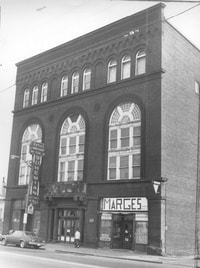
Bohemian National Hall
By Danielle Rose In the early 1880s, an idea arose in the Lodge Bratri v Kruhu of the Czech Slovak Benevolent Association that people of Bohemian nationality needed a community building dedicated to their societies and culture. In August 1887, Bohemian representatives met to discuss the possibility of creating such a space. The cornerstone for Bohemian National Hall was laid on December 20, 1896, and was dedicated the following September. During the dedication ceremonies, all local Bohemian communities and societies were invited to participate... |
Historic Bohemian National Hall in ClevelandSokol Greater Cleveland and other organizations hosted an event commemorating the centennial of the founding of Czechoslovakia 100 years ago at the Czech Cultural Center in Historic Bohemian National Hall in Cleveland Ohio. In that very hall the Cleveland Agreement of 1915 started the creation of the nation of Czechoslovakia. MC Alice Khol told the history of the Historic Bohemian National Hall. http://www.clevelandpeople.com/groups..., http://www.clevelandpeople.com/groups... and http://www.clevelandpeople.com/groups...
Cleveland Agreement between Czechs and Slovaks in 1915Stephen J Sebesta, PhD spoke at the 100th anniversary commemoration of the Cleveland Agreement at the Historic Bohemian National Hall on Broadway Ave. in Cleveland. His speech was titled “The Cleveland Agreement – The First Major Declaration of Cooperation between Czechs and Slovaks in the US to support an independent Czechoslovakian State.” This is a part of his speech. http://www.clevelandpeople.com/groups... and http://www.clevelandpeople.com/groups...
Explains the history and activities within the Czech Cultural Center and Sokol Greater Cleveland at Bohemian National Hall.
|

Danielle Rose, “Bohemian National Hall,” Cleveland Historical
https://clevelandhistorical.org/items/show/739 Broadway Avenue Historic District (Cleveland, Ohio)The Broadway Avenue Historic District is a historic commercial district in the North Broadway neighborhood of Cleveland, Ohio, in the United States. The commercial district is the historic center of Cleveland's Czech community, and is an excellent example of a district that grew along a streetcar line
A vacant, crumbling Bohemian-style home on E. 55th Street
The Settlement, Growth and Movement of the Czechs and their Institutions in Cleveland, Ohio
This presentation from Stephen J. Sebesta, Ph.D. accompanies his book of the same name. Highlighted with many photos, maps and graphics, it will review the history of the Bohemians, Moravians, and Silesians in Europe, collectively known as the Czechs, and the forces that led them to emigrate. It will trace immigration patterns of the Czechs in the U.S. more broadly with a more detailed descriptions of the Czech settlements in Cleveland, Ohio, which, in 1910, had the fourth largest population of Czech born inhabitants in the world exceeded only by Chicago, Vienna, and Prague.
Purchase "The Settlement, Growth and Movement of the Czechs and their Institutions in Cleveland, Ohio" at https://store.ncsml.org/product/settl....
SHOW LESS |
Slovaks
SLOVAKS. At one time in the early 1900s, Cleveland was reputedly the city with the largest number of Slovaks in the world. As of 1970 an estimated 48,000 persons of Slovak birth or ancestry resided in Greater Cleveland, making Slovaks one of the city's major immigrant groups. However, it is impossible to deduce the exact number of Slovaks resident in the city at any time, since, except for a brief period during WORLD WAR II, the Slovak state has not existed in modern times. Slovak immigrants were therefore listed as Austrian or Hungarian prior to WORLD WAR I, or as Czechoslovakian following the war. This lack of official identity forms, perhaps, the main aspect of the local community's history; one of its chief goals has been the recognition of its ethnic distinctiveness as well as of its cultural contributions.
Immigration to Cleveland began in the late 1870s, when the city's immigrant officer began counting a large number of "Slavonians" (perhaps Slovaks and SLOVENES) arriving in the city. It is estimated that there were 35,000 Slovaks in the city by...
Immigration to Cleveland began in the late 1870s, when the city's immigrant officer began counting a large number of "Slavonians" (perhaps Slovaks and SLOVENES) arriving in the city. It is estimated that there were 35,000 Slovaks in the city by...
|
Neighborhoods They Settled In: Clark Fulton, Industrial Valley, Stockyards, Brooklyn Center, Tremont, Central.
First Immigrants 1877 Cleveland’s first Slovak immigrant is said to be Jan Roskos, who was already here when the city’s second Slovak, Jacob Gruss, arrived in 1880. Most Slovak immigrants to America were choosing to work in the coal mining towns of Pennsylvania or West Virginia. But opportunities in Cleveland gave them a chance to work above ground. Slovak immigrants to Cleveland came primarily from the Eastern part of what was then known as Northern Hungary, part of the Austro-Hungarian Empire. Slovak immigration began in the 1880s, reached its peak at the turn of the 20th century, and eventually tapered off with the beginning of World War I. The usual pattern would be for men to leave Europe with the hope of making enough money so their family could live comfortably in Europe. Some actually did this. But the majority found the American dream and sent money to Europe so their wives and children or other members of their families could enjoy life here. In Europe and when they arrived in America, these early immigrants would have been classified as Hungarians. And in America as they sought jobs, these new immigrants faced many employers who never even heard of the term Slovak and had no idea where these new immigrants were from. Cleveland Slovaks established parishes as the anchors for their communities, and many found themselves living near some of the same people who were... Matica Slovenska visits Cleveland, Ohio—1936This video recounts the visit to Cleveland Ohio in April 1936 by members of the Matica Slovenska, Slovakia's scientific and cultural institution focusing on topics around the Slovak nation. Besides showing the size of Cleveland's Slovak community at the time, the video includes scenes of downtown Cleveland in 1936 and the Great Lakes Exhibition, which was currently open in Cleveland. Also shown are early photos of Benedictine High School, its students and faculty. Film was shot by the Match Slovenska with original captions in Slovak. English translations have been added.
Cleveland is to Slovaks what Selma is to African-Americans
George Terbrack received the Freedom Award from the American Nationality Movement (ANM) at the ANM Christmas event at the German Cultural Center in Olmsted Falls (Cleveland) Ohio. The event also celebrated the 100th birthday of former Cleveland Mayor Ralph J. Perk. George told of the monumental Cleveland agreement that was the start of civil rights for the Czech and Slovak people. He said that Selma Alabama was the birthplace of civil rights for African-American and Cleveland Ohio was the birthplace of civil rights movement for Czech and Slovak people. http://www.clevelandpeople.com/groups...
|
Fujara from Central Slovakia at One World Day in ClevelandThe 74th annual One World Day in the Cleveland Cultural Gardens featured performances in all of the Gardens including the Slovak Garden. Michael Anderko spoke about and demonstrated the fujara. The fujara is called Queen of the overtone flutes. Shepherds would use them to call sheep or other shepherds. It has three tone holes located on the lower part of the main body. The sound is produced by a fipple at the upper end of the main body of the fujara. Michael played a Slovakian folk song about a son telling how his father is poaching on the king’s land. http://www.clevelandpeople.com/groups...
Slovak Cultural Garden in Cleveland OhioGeorge Terbrack shows the Slovak Cultural Garden in Cleveland Ohio to Bratislava Mayor Milan Ftacnik. The Garden has busts of Slovak poet Ján Kollár and Stefan Furdek. http://www.clevelandpeople.com/groups...
Slovak Folk Dress (Kroje) from various regionsDenise Ivan-Antus and George Terbrak spoke at the 100th anniversary commemoration of the Cleveland Agreement at the Historic Bohemian National Hall on Broadway Ave. in Cleveland. George explained the Slovak and Czech folk dress called Kroje that was on display. http://www.clevelandpeople.com/groups... and http://www.clevelandpeople.com/groups...
Slovenske Mamicky in Cleveland
The trio Slovenske Mamicky sing about being Slovak and living in America at an improvised concert in North Royalton, OH.
|
Slovenians (Slovenes)
SLOVENES, a South Slav people whose homeland, Slovenia, declared its independence from Yugoslavia in 1991, began settling in Cleveland in the 1880s, with immigration heaviest in the periods 1890-1914, 1919-24, and 1949-60. Prior to WORLD WAR II, most emigrants were peasants from the economically underdeveloped rural areas of Slovenia, looking for economic betterment. The Slovenes who came after World War II were mainly political refugees, including a larger proportion of well-educated and professional individuals. The community was augmented by the 2nd generation, and also by Slovenes who came from elsewhere in the U.S. Cleveland became a magnet for Slovenes because of its rapidly expanding industrial base, requiring large numbers of unskilled and semiskilled laborers. Census data for 1910 listed 14,332 Slovenes in Cleveland, making it at the time the 3rd-largest Slovene city in the world. The 1970 census listed 46,000 foreign-born or mixed-parentage Slovenes in the Cleveland area. By the early 1900s, Cleveland had the largest Slovene settlement in the U.S., retaining that status into the 1990s.
The first Slovenes to arrive in Cleveland settled in the NEWBURGH area and found employment in the nearby steel industry. By the later 1880s and
The first Slovenes to arrive in Cleveland settled in the NEWBURGH area and found employment in the nearby steel industry. By the later 1880s and
|
Neighborhoods They Settled In: Old Brooklyn, Westpark, Tremont, Collinwood, Goodrich, St. Clair, Union.
First Immigrants 1880's The first Slovenians came to Cleveland between the 1880's and 1914. The first Slovenians settled in the Newburgh area. The oldest Slovenian settlement was in the vicinity of E. 81st between Union and Aetna. They also settled along St. Clair between E. 30th and E. 79th Streets. They have built four Catholic churches: St. Vitus founded in 1893 (serving the St. CLair community); St. Lawrence founded in 1901 in the Newburgh area; St. Mary’s Church organized in 1905 and located at Holmes and E. 156th St.; St. Christine founded in 1925 at E. 222nd Street in Euclid, Ohio. Two small communities developed on the west side, one in West Park and the other in the Denison neighborhood. 1942 Report by the WPA: Most of the Cleveland Slovenian settlers belonged to the industrial worker group who arrived between 1900 and 1914. The oldest Slovenian settlement was in the vicinity of E. 81st Street between Union Avenue... Kres Slovenian Folk Dance at Cleveland KurentovanjeThe Kres Slovenian Folk Dancers performed another traditional dance in bright costumes at the Fifth Annual Kurentovanje in Cleveland in the historic Slovenian National Home on St. Clair. http://www.clevelandpeople.com/groups...
Dancing in the Street at Cleveland Slovenian KurentovanjeMarchers and audience members danced in the street at the first annual Kurentovanje Festival in Cleveland. http://www.clevelandpeople.com/groups...
ASEF Gala 2017 in Cleveland, Ohio
ASEF Gala in Cleveland, celebrated Edi Gobec, the author of Slovenian American Inventors and Innovators - which is a brilliant result of years of fighting ignorance about Slovenia and Slovenians.
|
History of Slovenians in Cleveland and the United StatesThe Consul General of the Republic of Slovenia Mr. Andrej G. Rode hosted a reception in Honor of His Excellency Dr. Miro Cerar Prime Minister of the Republic of Slovenia on Friday, September 22, 2017 at the Slovenian National Home in Cleveland Ohio. Joe Valencic, president of the National Polka Hall of Fame, served as MC and gave a brief history of Slovenians in Cleveland and the US and the relationship with the Republic of Slovenia. http://www.clevelandpeople.com/groups...
2020 Slovenian Kurentovanje Parade in ClevelandKurentovanje is a Slovenian end of winter, Mardi Gras like festive event that takes place in Slovenia and also Cleveland Ohio which has the 2nd most people of Slovenian heritage in the world after Slovenia itself. The first part of the video is the start of the Parade on Lausche Ave., a side street. Then it finishes on St Clair Ave. with the crowds in front of the Slovenian National Home. http://www.clevelandpeople.com/groups...
Kenny learns more about the Slovenian Holiday KurentovanjeDeepening their roots in area, in the early to mid twentieth century the Azman family also called 6501 St. Clair Avenue their personal home, taking up residence ...
Slovenian Sausage Fest 2016
Scenes of the fest in Kirtland and talk with Slovenian ambassador.
|
Romanians
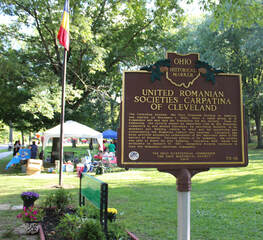
ROMANIANS
Among the new Southern and East European immigrants coming to Cleveland in the late 1800s were an increasing number of ethnic Romanians, most from the province of Transylvania, at that time part of Austria-Hungary. Other Cleveland Romanians came from the province of Bucovina on the Polish and Russian borders, also part of Austria-Hungary before WORLD WAR I. There were also a number of JEWS from the Old Kingdom of Romania. The first Romanians in any significant numbers came to Cleveland as solitary immigrants, usually at the urging of Hungarian, Saxon, Swabian, and Jewish acquaintances from back home, who had emigrated earlier. The flow of Romanian immigrants grew steadily and continued unabated until the outbreak of World War I. By that time, there were about 12,000 ethnic Romanians in Cleveland, overwhelmingly of peasant stock who found immigration an alternative to the restrictive social, political, and economic possibilities in their homeland. Romanians settled near their places of employment, so they could walk to and from work. The largest concentration was on the west side...
Encyclopedia of Cleveland History
https://case.edu/ech/articles/r/romanians
Among the new Southern and East European immigrants coming to Cleveland in the late 1800s were an increasing number of ethnic Romanians, most from the province of Transylvania, at that time part of Austria-Hungary. Other Cleveland Romanians came from the province of Bucovina on the Polish and Russian borders, also part of Austria-Hungary before WORLD WAR I. There were also a number of JEWS from the Old Kingdom of Romania. The first Romanians in any significant numbers came to Cleveland as solitary immigrants, usually at the urging of Hungarian, Saxon, Swabian, and Jewish acquaintances from back home, who had emigrated earlier. The flow of Romanian immigrants grew steadily and continued unabated until the outbreak of World War I. By that time, there were about 12,000 ethnic Romanians in Cleveland, overwhelmingly of peasant stock who found immigration an alternative to the restrictive social, political, and economic possibilities in their homeland. Romanians settled near their places of employment, so they could walk to and from work. The largest concentration was on the west side...
Encyclopedia of Cleveland History
https://case.edu/ech/articles/r/romanians
Other links:Romanian Cultural Garden in Cleveland OhioThe Romanian Cultural Garden was dedicated in 1967. It is part of the Cleveland Cultural Gardens. Along with an Ohio Historical Marker telling about the United Romanian Societies and Carpatina there is a statue of Romanian composer, violin virtuoso and conductor George Enescu. http://www.clevelandpeople.com/groups...
Romanian Festival Cleveland Ohio
Here is the romanian festival that I attended last weekend at St Marys Romanian Eastern Orthodox Cathedral here in Cleveland Ohio just south of I90 on Warren Rd. Here you'll see alot of traditional clothing, food, and dancing along with the cathedral itself. Also you'll hear some romanian language and hear traditional music as well. Hope you all enjoy it. Look forward to seeing you all there next year.
|
A tour of the Romanian Museum in Cleveland -- Part 1Ovidiu Lucian Vatamanu, a member of St. Mary's Romanian Orthodox Church, begins a tour of the Romanian Museum in Cleveland. This is the only such museum in the United States for Romanian art and culture. http://www.clevelandpeople.com/groups...
Romanian fest at St.Mary Cleveland OH.
Romanian annual festival at St.Mary orthodox cathedral, fantastic music helped by Romanian sax kiddie, dancing, superb food and hospitality all in one place, felt like at home, keep up good work, recorded at St.Mary orthodox cathedral playground Cleveland OH, August-17-2013.
SHOW LESS by T Andrica · Cited by 5 — permission of Cleveland State University's Ethnic Heritage Studies. /. Copyright © by ... New Year's Goat Dance by Romanians in Cleveland. George Enescu.
|
Italians
ITALIANS. Although Italian names can be found in Cleveland city directories from the late 1850s, not until the Civil War did an Italian community begin forming in the city. The 1870 census listed 35 Italians in Cleveland; during the following 50 years, more than 20,000 Italian immigrants came to the city. Most immigrants were contadini (peasants) from the Mezzogiorno (southern Italy), where extreme poverty and government negligence brought unbearable hardship. The history of Cleveland's Italians comprises 3 separate stages: formation (1870-1929); transformation (1930-45); and realization (1945 to the present).
By the late 1920s, the formative period was complete; 6 Italian neighborhoods had been established. The largest was BIG ITALY, located along Woodland and Orange avenues from E. 9th St. to E. 40th St. LITTLE ITALY, centered at Mayfield and Murray Hill roads, proved the most enduring of the settlements. Nearby, at...
By the late 1920s, the formative period was complete; 6 Italian neighborhoods had been established. The largest was BIG ITALY, located along Woodland and Orange avenues from E. 9th St. to E. 40th St. LITTLE ITALY, centered at Mayfield and Murray Hill roads, proved the most enduring of the settlements. Nearby, at...
|
Neighborhoods They Settled In: Central, Collinwood, Mount Pleasant, University Circle/Little Italy, Clark/Fulton, Detroit Shoreway, Industrial Valley, Old Brooklyn, Stockyards.
First Immigrants 1860's By 1870 there were 35 native Italians in Cleveland who settled in the Ontario Street market district. Most found employment in the marble works on Mayfield Road. It was here that the Italians started their first colony called “Little Italy”, located at Mayfield and Murray Hill Roads. There was also Big Italy, located along Woodland and Orange Avenues from E. 9th to E. 40th. At E. 107th and Cedar Avenue a community grew around St. Marian Church. On the west side there were two settlements, one near Clark and Fulton Avenues (St. Rocco's Church) and one on Detroit near W. 65th Street (Our Lady of Mount Carmel). Another community was eventually formed by people moving out of Big Italy to the Woodland and E. 116th St. area. Another large population of Italians can be found in the Village of Cuyahoga Heights and the Warner Road area. Most of the Italian immigrants who came after the turn of the century worked on bridges, sewers and streetcar tracks. Big Italy was located close to the markets and became the center of the fruit industry. In Little Italy, the occupations were tailoring, monument work, and gardening. The Italians created the "Hometown society". This was a way for them to meet and talk about family and... THE ITALIAN COMMUNITY OF CLEVELAND
Chapter 7 THE ITALIANS OF CLEVELAND: AN INTRODUCTION Sources Cleveland's Italian community is one of the most colorful and vital of the city's 60 ethnic groups and has been a favorite topic of area writers. Although one of the most recent groups to immigrate to Cleveland, the Italian population has nevertheless been the subject of several studies over the last half century as well as a series of less extensive but equally important articles... 36th Cleveland Challenge Cup of Bocce Finals Game 1
Utica's Finest Barbershop 7-0 (Utica/Rome, NY) vs. ABV Contractors 6-1 (Willoughby/Little Italy, OH) Finals Date: 2019-08-25 Commentators: Bob Gallese, Luciano DeSensi, Frank Gambatese #CCCB36 is a 100+ bocce teams double elimination tournament at the Wickliffe Italian-American Club.
19 best Italian restaurants in Greater Cleveland: 2017 A-List Dining Guide (photos) · Aldo's Restaurant · Bruno's Ristorante, · Cibreo Italian Kitchen, ...
|
Four Italian American Parishes in Cleveland, OhioHighlights the four main Italian American Catholic Churches presently located in the Diocese of Cleveland, Ohio: Holy Rosary, Saint Rocco, Our Lady of Mount Carmel - West, and Holy Redeemer. Three of the Four Parishes were founded by the following Mercedarian Friars: Father Sante Gattuso, O. de M., Father Martin Compagno, O. de M. and Father Vincent Caruso, O. de M. For more information about the Order of Mercy please visit our website: www.orderofmercy.org
Little Italy: Cleveland's Most Passionate NeighborhoodAnother http://www.CoolCleveland.com video exclusive. Little Italy is the most European neighborhood in Cleveland. The tiny winding streets are still made of brick. Buildings are so close to each other and the streets that the shops and restaurants spill their sounds and people onto the sidewalks and roadways out front. All this jostling makes a walk down Murray Hill or Mayfield Roads in the neighborhood a cultural experience. This tiny neighborhood overflows with fantastic places to eat that run the gamut from casual pizzerias to elegant inns, wine bars to Bohemian coffee houses, traditional bakeries to trendy bistros, friendly sidewalk cafes to swanky night clubs. Little Italy is teeming with artists and galleries. Sculpture is still present in the form of glass, architecture, fabric, clothing and hats, paper, woodworking, jewelry and ceramics. More modern art forms you'll find in Little Italy include photography, film, video and design, as well as that most classic of art forms, painting.
Get a taste of the 119th Feast of the Assumption in Cleveland's Little ItalyTake a look at what you'll find at the 119th Feast of the Assumption.
|
The Balkans & Southern Slavs...
1880-1924
BALKAN IMMIGRANTS
Bulgarians, Albanians, and Montenegrins constitute the principal Balkan groups in Cleveland. The major period of Balkan immigration to the U.S. occurred from 1880-1924, prompted by economic stress and political changes in the Balkan countries. The economic condition of Balkan peasants had deteriorated because of industrialization, foreign competition, agricultural commercialization, and population growth. Political unrest and demands for independence following the retreat of the Ottoman Empire created uncertainty and instability. Natural disasters further prompted many Balkans to leave...
Encyclopedia of Cleveland History
https://case.edu/ech/articles/b/balkan-immigrants
Bulgarians, Albanians, and Montenegrins constitute the principal Balkan groups in Cleveland. The major period of Balkan immigration to the U.S. occurred from 1880-1924, prompted by economic stress and political changes in the Balkan countries. The economic condition of Balkan peasants had deteriorated because of industrialization, foreign competition, agricultural commercialization, and population growth. Political unrest and demands for independence following the retreat of the Ottoman Empire created uncertainty and instability. Natural disasters further prompted many Balkans to leave...
Encyclopedia of Cleveland History
https://case.edu/ech/articles/b/balkan-immigrants
In 1978 and 1979, the Greater Cleveland Ethnographic Museum began to record Balkan Slavic music — music from Bulgarian, Croatian, Macedonian and ...
Bulgarians
Bulgarians
Bulgarian immigration to Cleveland divides into 2 periods: turn-of-the-century immigration (1880-1924) and post-World War II refugee immigration, with most arriving during the first period. This group may be further divided into immigration prior to or after the Balkan War of 1912. Bulgarians arriving before 1912 represented every social and economic class. Most were young men; many converted to Protestantism in Bulgaria; and they came intending to settle permanently in America.
The Bulgarians arriving after 1912 were generally peasants who came for economic reasons...
Encyclopedia of Cleveland History
https://case.edu/ech/articles/b/balkan-immigrants
Bulgarian immigration to Cleveland divides into 2 periods: turn-of-the-century immigration (1880-1924) and post-World War II refugee immigration, with most arriving during the first period. This group may be further divided into immigration prior to or after the Balkan War of 1912. Bulgarians arriving before 1912 represented every social and economic class. Most were young men; many converted to Protestantism in Bulgaria; and they came intending to settle permanently in America.
The Bulgarians arriving after 1912 were generally peasants who came for economic reasons...
Encyclopedia of Cleveland History
https://case.edu/ech/articles/b/balkan-immigrants
Other links:KABILE Bulgarian Wedding Ban
Kabile is a top favorite in the south and east Thrace (Trakija) regions of Bulgaria for weddings, baptisms and other cultural celebrations. Dzhenko Andreev (gajda/bagpipe), Angel Krastev (tapan/ large drum) Nikolay Doktorov (kaval/ end-blown wooden flute) , Nikolay Kolev (gadulka/ folk fiddle), Ivan Handzhiev (accordion and vocals), and Donka Koleva (vocals) are excellent representatives of this traditional style. KABILE will perform in Cleveland, Ohio on Saturday, September 13, 2008. For reservations, call 216-991-3432 X12
|
Bulgarian churches in the United States (Ohio):Bulgarian Diocese of USA & Canada
2760 Hemlock St. Toledo, OH 43814 Holy Ghost Church 18 S. Richview Ave. Youngstown, OH 44509 330-792-9119 St Elia the Prophet Church 64 W. Wilbeth Rd. Akron, OH 44301 330-724-7129 St George Cathedral 137 Oswald St. Toledo, OH 43605 419-691-8913 St Thomas – Eastern Orthodox Church 555 S. Cleveland Massillon Rd Fairlawn, OH 44333 330-666-8006 Anyone can see who's in the group and what they post. Visible. Anyone can find this group. Cleveland, Ohio. General Group. History. Group created on May 9, ...
|
Albanians
|
ALBANIANS are today one of Greater Cleveland's most prominent ethnic communities, growing significantly since the fall of communism in Albania in 1992. They arrived in Cleveland in four distinct waves: late 19th century (1890s), early 20th century (1900-1938), post-World War II (1945-1992), and after the fall of communism (1992-present).
Cleveland's earliest Albanian immigrants arrived from Italy in the 1890s, as part of the large influx of ITALIAN immigrants. Known as the Arbëreshë, these Albanians were descendants of those who fled to southern Italy in order to escape the Ottoman invasion of their homeland in the Middle Ages. The second wave of Albanians came to Cleveland from Korçë... Ilir Pipa at Albanian Cultural Garden in Cleveland
Kleida Spirollari, Treasurer of the Albanian American Association of Cleveland welcomed the crowed to the Albanian Cultural Garden in Cleveland Ohio. She introduced Board Member Ilir Pipa who explained the newly completed Phase II of the Albanian Garden which includes walkways, a fountain and lights so that the garden can be used by the community and for events. http://www.clevelandpeople.com/groups...
|
Albanian-American Association of ClevelandThe Albanian-American Association of Cleveland was established in 1998. The association is a voluntary organization for the Albanian-American community and works without any benefit payment to members of Officer (practitioners of tasks). Any incomes will only the purposes and goals of the association. Read More...
Albanian artist Fate Velaj in Cleveland
Highly acclaimed Albanian artist Fate Velaj spoke in the Cleveland City Hall Rotunda where his photographs of Albania were on display in an exhibit called ‘Albania – seen differently.” Velaj is the recipient of many awards, including the “Albanian Excellence Award” given to him in 2012 on the occasion of the 100th anniversary of Albania’s independence. Anila Nicklos translated Velaj’s words from Albanian to English. http://www.clevelandpeople.com/groups...
St. E. Premte Church Cleveland, OhioFounded 1938
Diocese: Albanian Archdiocese Deanery: Great Lakes Deanery Address10716 Jasper Rd Cleveland, Ohio 44111 Church: 216-941-1508 |
Montenegrins
|
MONTENEGRINS settled in Cleveland during three periods: the turn of the century (1890-1914), after World War II (1945-1922), and after the dissolution of Socialist Yugoslavia in 1992 (Montenegro became officially independent from the State Union of Serbia-Montenegro in 2006). Most Montenegrin immigrants who arrived in the first wave were...
Montenegrin Ohioans
Numerous Ohioans are descended from Montenegrin ancestors. During the late nineteenth and early twentieth centuries, millions of immigrants migrated to the United States of America, hoping to live the American Dream. Before the American Civil War, most immigrants arrived in the United States from Great Britain, Germany, and Ireland. By the 1880s, the home countries of immigrants began to change. Many of the new immigrants to arrive in the United States came from Eastern and Southern European countries, like Montenegro, Albania, Poland, Hungary, Lithuania, and Czechoslovakia, rather than from Western European countries, like Great Britain, Ireland, and Germany. In 1860, 328,249 immigrants lived in Ohio. These people accounted for fourteen percent of |
Montenegro Folk Song by Serbian Men’s Choir Kosovo
Serbian Men’s Choir Kosovo under the direction of Dr. Rick Zivic, DDS performed in the Serbian Cultural Garden in Cleveland at the dedication of the new bust of Mileva Maric the Serbian physicist and mathematician who was the wife and scientific partner of Albert Einstein. This song was a Montenegro Folk Song. http://www.clevelandpeople.com/groups...
|
Serbians
|
SERBS
Although the Serbs are not one of Cleveland's largest ethnic groups, they have made themselves widely known throughout the city. Serbian immigration to Cleveland came in 2 main periods: from the beginning of the 20th century to the beginning of WORLD WAR I, and from the end of WORLD WAR II to the mid-1980s. Serbs as a group maintain a strong ethnic identity, and while they adapt readily to American life, they do not quickly assimilate into American society. Many, although they may be 3rd- or 4th-generation American Serbs, maintain traditional beliefs and customs. Lazar Krivokapic, a Serb from Montenegro who settled in Cleveland in 1893, is considered the city's first Serb. It was not until after the turn of the century, however, that significant numbers of Serbs came to Cleveland. Virtually all of these Serbs were not from Serbia but from the Austrian Military Frontier in Croatia; consequently, they were part of the enormous migration from the Austro-Hungarian Empire. The largest group came from the area called Lika, while many others came from Banija, Kordun, Backa, and the Banat. There were also a significant number from Dalmatia and some from Montenegro... 
Serbian Cultural Garden
By The Cleveland Historical team https://clevelandhistorical.org/items/show/137 Dedicated on October 5, 2008, the Serbian Cultural Garden features a central plaza with a marble cube and circular concrete seating. The plaza also contatins the garden’s message: “Only Unity Saves The Serbs”. A pebble mosaic surrounds the cube. It is a reproduction of mosaics found at the Hilandar Monastery (Greece) and at the Patriarchate of Pec and Zica Monasteries (Serbia).
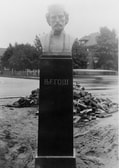
Cleveland's Serbian community placed the bust of Petar II Petrovic-Njegos in the original Yugoslav Garden in 1936. In the 1990s, as Yugoslavia collapsed, the bust was moved to the grounds of St. Sava Eastern Orthodox Church in Broadview Heights. The bust returned to Rockefeller Park in 2008 with the opening of the new Serbian Cultural Garden.
https://clevelandhistorical.org/files/show/1355 |
Other links:Serbian Churches (Ohio)Kenny previews One World DayFOX 8 News Cleveland
For over 70 years Northeast Ohio has celebrated One World Day at the Cultural Gardens on Martin Luther King Boulevard. Fox 8's Kenny Crumpton previewed this year's event. https://clevelandoneworldday.org/2019/ Vaskrs, Easter 2012 St Sava Serbian Orthodox Cathedral, Cleveland, OhioHoly Liturgy
|
Bosnians
|
People, culture, music, food and traditions from Bosnia and Bosnian-American community in Cleveland Ohio and beyond.
On 21 November 1995, in Dayton, Ohio, the warring parties initialed a peace agreement that ended three years of interethnic civil strife (the final agreement was signed in Paris on 14 December 1995).
|
Dayton International Peace Museum
Founded in 2004, the Dayton International Peace Museum raises awareness of nonviolent strategies for achieving peace now and in the future. The Dayton International Peace Museum was founded by J. Frederick Arment, Ralph and Christine Dull, Steve Fryburg and Lisa Wolters. It honors the 1995 Dayton Peace Accords that ended war in Bosnia. Our mission is to inspire a local, national, and international culture of peace. Learn more »
|
Croatians
CROATIANS. In 1990 Greater Cleveland contained over 15,000 people whose primary ancestry was Croatian, the 4th-largest concentration of Croatians in the U.S., after Pittsburgh, Chicago, and New York. During the two world wars, and in the period 1950-70, Cleveland was a main center of Croatian and South Slavic political, fraternal, and cultural activities. A South Slavic people, the Croatian immigrants to Cleveland were part of a centuries-long migration from Croatia. The exodus reached its peak ca. 1910, repeated some 50 years later. All waves of Croatian immigration to Cleveland and America were caused by...
|
Neighborhoods They Settled In: Goodrich, St. Clair
First Immigrants Early 1900's The Croatians settled around E. 40th Street. Another area was between E. 26th and E. 31st. The heart of the old Croatian settlement remains around E. 40th where St. Paul Church and school, built in 1903, are located. The other Croatian parish, St. Nicholas, was founded in 1902 at Superior and E. 36th. 1942 Report by the WPA: The second Jugoslav group to come to Cleveland were the Croats or Croatians. The first Croatian settlement in Cleveland was Old King Street from E. 33rd to E. 40th north of St. Clair. Today the areas around... https://sites.google.com/site/clevelandanditsneighborhoods/home/ethnic-groups-in-cleveland/croatians
Croatian Segment New Day Cleveland
Traditional Croatian music and dance at Cleveland Art Museum
The Croatian Cultural Group Kordun from the Croatian Heritage Museum & Library in Eastlake Ohio performed traditional Croatian music and dance in traditional Croatian costumes at the Cleveland Museum of Art’s International Cleveland Community Day in the Atrium of the museum. http://www.clevelandpeople.com/groups...
Croatian dance and music - American Zagreb Jr. Tamburitzans
The American Zagreb Jr. Tamburitzans performed an authentic Croatian dance wearing authentic Croatian costumes and playing authentic Croatian instruments at International Cleveland Community Day in the Atrium of the Cleveland Museum of Art. http://www.clevelandpeople.com/groups...
|

If you are looking for interesting events in Cleveland, where you can connect and network with Croatians, or if you are organizing an interesting event, you are at the right place!
If you are interested in the latest news about Croatians in Cleveland and Croatia, this is your news box! Cleveland and North East Ohio is a home to about 40 000 people of Croatian descent. Croatians started moving to Cleveland area in the 19th century and have established a footprint for generations to follow. Croatiansincleveland.com is the largest Croatian community in Cleveland. It exists to connect Croatian community in Cleveland and surrounding cities in North East Ohio. Our goal is to encourage Croatians to connect and network as well as promote the Croatian culture and heritage Croatians in Cleveland celebrate Christmas
The Cleveland Museum of Croatian Culture and Heritage opened today its Christmas exhibition. The exhibition will run until January 15, 2020. http://croatiansincleveland.com/wp-co... The Christmas exhibit shows the motifs and costumes that Croats once wore, and especially how it looked during the Christmas holidays. Through his unselfish efforts, the Museum of Croatian Heritage managed to preserve the tradition of the Christmas culture of the Croats. A great opportunity for Croatian children to look and see how people once did to prepare for Christmas and also for Americans to learn about Croatian culture. This exhibition has been preparing for 35 years on an annual basis. This event was also celebrated with the tamburitza band Žumberčani, who have been active and performing for years not only in Cleveland, but all over America and Canada, and guest appearance in Croatia. The Museum of Croatian Culture and Heritage was founded in 1983 and encompasses the Library, the Croatian Cultural Garden and the museum itself. The museum is held by generous donations and sponsors and also by its volunteers. Museum Curator Branka Malinar invites all Croatians who live in northeast Ohio to come and see this special exhibition and to get acquainted with the activities of the museum, learn more about its origins and culture and, of course, all other guests who want to learn about Croatian culture and its customs. The museum is open Fridays from 12pm – 6pm 34900 Lakeshore Blvd Eastlake OH 44095 More information about the museum can be found on their website: http://www.croatianmuseum.com
The Croatian Heritage Museum and Library
|
African American Migration
World War I
through the Great Migration...
African Americans
AFRICAN AMERICANS. Cleveland's African American community is almost as old as the city itself. GEORGE PEAKE, the first black settler, arrived in 1809 and by 1860 there were 799 blacks living in a growing community of over 43,000. As early as the 1850s, most of Cleveland's African American population lived on the east side. But black and white families were usually interspersed; until the beginning of the 20th century, nothing resembling a black ghetto existed in the city. Throughout most of the 19th century, the social and economic status of African Americans in Cleveland was superior to that in other northern communities. By the late 1840s, the public schools were integrated and segregation in theaters, restaurants, and hotels was infrequent. Interracial violence seldom occurred. Black Clevelanders suffered less occupational...
Cleveland Historical Team
African Americans in Cleveland
Curated by The Cleveland Historical Team This tour offers a sampling of stories that collectively tell a broader story about African American life in Cleveland in the twentieth century. Following the Great Migration in the 1910s and 1920s, Cleveland's black population soared. Cleveland Memory
Notable Blacks of Cleveland contains approximately 2000 images of 500 individuals selected from the photographs in the Cleveland Press Collection. This collection was donated to the Cleveland State University Library when that newspaper ceased publication in 1982. The photographs in the collection generally date from the 1920's on, with most of them from 1960 to 1982. The collection is arranged alphabetically by the last name of the individuals. Links have been provided to biographies that are available in the Encyclopedia of Cleveland History.
Browse images of notable Blacks by field
Miles Heights Village: The Making of Cleveland's Black SuburbIt’s widely known that Carl Stokes was the first African-American elected mayor of a major U.S. city – but he wasn’t the first elected in the state of Ohio. That honor goes to Mayor Arthur Johnston and the Village of Miles Heights – that no longer exist. Miles Heights began as an enclave of shacks and shanties that went up in the Lee-Seville and Harvard Avenue area in the early 20th century. Available land, the search for a better life and opportunity attracted black builders and homebuyers to the area. In 1927, the residents organized and formed Miles Heights Village. The Village however was short lived. A few years later, the City of Cleveland annexed the newly formed community becoming a part of Ward 1. Today, a park named after Mayor Johnston is at 4583 East 144 St.
Teaching Cleveland Digital www.teachingcleveland.orgAfrican American Cultural Garden Design Cleveland, Ohio VIDEO
The African American Cultural Garden Task force commissioned architect, W. Daniel Bickerstaff II of Ubiquitous Design, Ltd. to design the garden. Through extensive research the design conceptually represents and celebrates The African American Experience via it's PAST, PRESENT AND FUTURE :
JazzFestTri-C JazzFest Cleveland is an educational festival with year-round programming that culimates in a three-day summer music festival that takes place at Playhouse Square, located at 1501 Euclid Ave. in Cleveland, Ohio. Nearly 500 artists perform indoors and outdoors playing jazz and other genres. Indoor concerts are ticketed and feature world-class musicians in Playhouse Square's historic theaters. All outdoor entertainment is free.
Founded in 1980 by Dr. Thom Horning and Reginald Buckner, Tri-C JazzFest stays true to its mission to:
The Evolution of Jazz in Cleveland
Orlando Watson sits down with some of Cleveland's most well versed jazz connoisseurs for a round table discussion about the evolution of jazz in the city. Cleveland may be know as the city of rock and roll, but jazz is not to be forgotten in the city's history. For more information on Tri-C JazzFest and its history click the link below. https://www.tri-c.edu/jazzfest/histor...
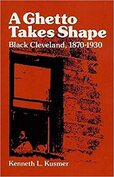
A Ghetto Takes Shape: Black Cleveland 1870 1930 is an eye opener. Tracing the development of Cleveland's Black Community from its antebellum beginnings to the end of the 1920's. This volume deals in a comprehensive way with more aspect of black life-economic, political, social and cultural-than any previous study of an urban community and presents the most detailed analysis of black occupations available.
|
Cleveland: African-Americans, the 1st 200 years.A short summary of 200 years of African-American life in Cleveland, Ohio.
The Great Black Migration and How It Changed America: African-American History (1991)The Great Migration was the movement of 6 million African Americans out of the rural Southern United States to the urban Northeast, Midwest, and West that lasted up until the 1960s. About the book: https://www.amazon.com/gp/product/067...
The meaning of Juneteenth Cleveland African-American GardenDr. Eugene Jordan, chair of the African-American Cultural Garden in Cleveland introduces Bill Silver B Richards who introduces Preston Bell who explains what Juneteenth is all about
The Great MigrationThe Great Migration of African-Americans out of the South began around the turn of the twentieth century and lasted through the 1960s. During that time, more than six million blacks moved from America’s rural south to the North, Midwest, and West.
Cleveland became the destination for people from the southern Appalachians and Piedmont region seeking a better life than the South offered, including gainful employment. Starting before the Civil War, Cleveland had a strong abolitionist community, thus the climate here was more accepting of different races than in some other northern cities. The center of the African-American community in Cleveland in the mid-nineteenth century was the old Haymarket district on Central Avenue. Although blacks lived primarily in three east-side wards of the City, each of these wards was thoroughly integrated. Most lecture halls, schools, restaurants... Memories of Cleveland's Fairfax neighborhood in the 1950s
Harry Winfield lived in Cleveland's Fairfax neighborhood during the 1950's and 60's. He remembers the people, the places and what life was like in the neighborhood during an interview at the Fairfax Renaissance Development Corporation. This video was made in partnership with FreshWater Cleveland: https://www.freshwatercleveland.com/f...
Photographs of hundreds of individuals who made a significant contribution beyond their own personal and family lives to the history and development of Cleveland.
Carl B Stokes - Cleveland's first black mayor
Despite growing up in poverty and dropping out of high school at 17, Stokes went on to pass the Ohio law bar, become the first black person elected Democratic State Representative for Ohio, and ultimately became the first black elected as mayor of a major American city. CORRECTION: The year of the Glennville riots was 1968, not 1969 as stated in the video.
Black History: Cleveland History Center
The Cleveland History Center does our city proud. Every exhibit — from “Cleveland Starts Here” to “Carl and Louis Stokes: Making History” — overflows with artifacts, memorabilia and thought-provoking stories from the most impactful Clevelanders. During Black History Month, the Center also provides a timely reminder of Cleveland’s place on the vanguard of the civil rights movement. Prepare to be impressed — and inspired.
Surrogate Suburbs: Black Upward Mobility and Neighborhood Change in Cleveland, 1900–1980
by Todd M. Michney 
The story of white flight and the neglect of black urban neighborhoods has been well told by urban historians in recent decades. Yet much of this scholarship has downplayed black agency and tended to portray African Americans as victims of structural forces beyond their control. In this history of Cleveland's black middle class, Todd Michney uncovers the creative ways that members of this nascent community established footholds in areas outside the overcrowded, inner-city neighborhoods to which most African Americans were consigned. In asserting their right to these outer-city spaces, African Americans appealed to city officials, allied with politically progressive whites (notably Jewish activists), and relied upon both black and white developers and real estate agents to expand these "surrogate suburbs" and maintain their livability until the bona fide suburbs became more accessible.
By tracking the trajectories of those who, in spite of racism, were able to succeed, Michney offers a valuable counterweight to histories that have focused on racial conflict and black poverty and tells the neglected story of the black middle class in America's cities prior to the 1960s. |
Ukrainian, Hungarian, Hispanic, and Jewish communities
The Great Depression
through the 1950s...
Ukrainians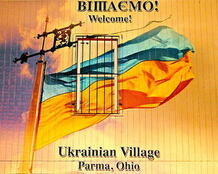
UKRAINIANS
The first large groups of Ukrainians arrived in America in the 1870s from the Lemko, Carpatho-Ruthenia, and Galitsian (Halycchyna) regions. Their numbers are difficult to determine, because they were counted as Austrians, HUNGARIANS, POLES, or RUSSIANS, the groups that at one time or another occupied Ukraine. Most were known as Ruthenians after the name of their former state, Rus-Ukraine. They mainly emigrated for economic reasons, planning to work, get wealthy, return home, and buy land. World War I, however, caused them to settle as permanent residents. The first Ukrainians arrived in the Cleveland area in the mid-1880s, settling mainly on the west side in the TREMONT area... Encyclopedia of Cleveland History https://case.edu/ech/articles/u/ukrainians Коломийка - Kolomyika dance - Cleveland Ohio Wedding VideographyOther links:Ukrainian Museum-Archives in Cleveland OhioThere is a terrific hidden gem in Cleveland's Tremont neighborhood that anyone interested in culture should visit. The Ukrainian Museum-Archives is located at 1202 Kenilworth Ave in Tremont.
Museum Hours:
Tuesdays, Wednesdays, Thursdays, Fridays and Saturdays - 10 to 3 PM (or by prior appointment). The Museum is free but consider patronizing the gift shop and/or leaving a donation to keep this wonderful facility operating. Directions to and contact information for the Museum Native costumes from Ukraine from the Ukrainian Museum-Archives Beautiful Pysanka (Decorated Ukrainian Easter eggs) from Ukraine |
Ukrainian Festival 2013 in Parma (Cleveland) OhioYoung ladies from Kashtan Ukrainian Dancers in Cleveland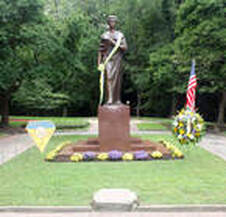
Lesya Ukrainka statue in the Ukrainian Garden
Lesya Ukrainka Statue Rededication
Taste of Ukrainian Village – Ukrainian Village In Parma Ohio
Ukrainian Village Highlighted in Cleveland Magazine's 'Rating the Suburbs' Feature ... Signature Event: Within sight of the majestic golden domes of St. Josaphat ... Top 10 Best Ukrainian Restaurant in Cleveland, OH - Last ...
Best Ukrainian Restaurant in Cleveland, OH · Olesia's Taverne. 16.2 mi. 4.0 star rating. 59 reviews · Kolos Andros Ukranian Bakery. 4.5 mi. Ukrainian, Bakeries. |
Hungarians
HUNGARIANS
Cleveland was at one time referred to as “the American Debrecen” following the popularly held belief that it was the city with the second largest population of Hungarians, outside of Hungary, after Budapest. Although this title did not hold up statistically (best estimates in the early 1900s would globally rank its Hungarian population as, perhaps, fourth largest), the popular name of “the American Debrecen” remained with the Cleveland Hungarian community in published books and magazines for many decades.
Cleveland was at one time referred to as “the American Debrecen” following the popularly held belief that it was the city with the second largest population of Hungarians, outside of Hungary, after Budapest. Although this title did not hold up statistically (best estimates in the early 1900s would globally rank its Hungarian population as, perhaps, fourth largest), the popular name of “the American Debrecen” remained with the Cleveland Hungarian community in published books and magazines for many decades.
|
Hungarian immigrants celebrating the sunflower harvest in Cleveland, 1913.
Hungarians came to Cleveland because of job availability, accessibility, and, as more Hungarians settled here, the proximity of countrymen. Hungarian immigration to Cleveland occurred in 3 distinct waves: turn-of-the-century immigration (1870-1924), the largest and most influential wave; post-WORLD WAR II "displaced persons;" and post-1956 refugee immigration. Hungarians who first arrived settled at the easternmost edge of the city, which became the Buckeye Rd....
Encyclopedia of Cleveland History https://case.edu/ech/articles/h/hungarians Other links:
The last Hungarian on Buckeye
Bognár Tibor 2004-es filmje a clevelandi Buckeye Road-on egykoron élő magyarokról. (A VHS sajnos nagyon rossz állapotban volt, arról lett digitalizálva)
Hungarian Cultural Garden in Cleveland – Upper level tour with Ernie MihalyThe Hungarian Cultural Garden is one of about 30 ethnic gardens in the Cleveland Cultural Gardens. It was established in the 1930’s, went through some down years and revitalized in the last 10-15 years. Ernie Mihaly was at the original dedication in 1938 and has maintained the Garden for years. In July 2019, Ernie took us on a tour of the upper half (East Blvd.) of the Hungarian Cultural Garden, which includes the Franz Liszt plaque, before a concert by a choir visiting from Hungary. Carolyn Balogh, current president of the Hungarian Cultural Garden, added some information as well. http://www.clevelandpeople.com/groups...
Balaton Restaurant, Cleveland-Ohio
While majority of our home cooked food are take-out, that is only half ... are done with your orders / reservations, you may Top 10 Best Hungarian Food in Cleveland, OH - Last Updated ...
Best Hungarian Food in Cleveland, OH · Balaton Restaurant. 4.3 mi. 4.0 star rating · European's Best Restaurant & Bakery. 14.7 mi. 4.0 star rating · Das Schnitzel ... Tony Packo's Cafe - Toledo, OH
|
Next to Budapest, city (Cleveland) had most Hungarians
|
Hispanic
Post-WWII: 1945-present
|
HISPANIC COMMUNITY
By the 1990s Spanish-speaking individuals constituted the fastest-growing portion of America's immigrant population. Though Cleveland's Spanish-speaking community did not grow as rapidly as those in Florida or California, it was, in 1990, the largest linguistically defined segment of the local population; 20,290 individuals in Greater Cleveland spoke Spanish. Composed of migrants from Puerto Rico and immigrants from Cuba, Mexico, South and Central America, and Spain, this segment of Cleveland's population has been referred to as Hispanic or Latino. Organizations such as the HISPANIC CULTURAL CENTER, and special governmental offices, such as the Mayor's Hispanic Liaison, serve the needs of the overall community. The overwhelming majority of the local Spanish-speaking population consists of Puerto Ricans. The Puerto Rican community of Cleveland is relatively new. Although a few Puerto Ricans settled in Cleveland following the Spanish-American War, and others arrived after WORLD WAR I, the largest influx to northern Ohio occurred between 1945-65. After WORLD WAR II, young unmarried Puerto Rican men were recruited to work in the factories of Lorain and in the greenhouses of northern Ohio. When their contracts terminated, many were attracted to Cleveland by... Cleveland's Mexican population has its roots in the 1920s, in the ... By 1920 there were 679 Mexicans in Cleveland, most working in factories.
Frequently requested statistics for: Cleveland city, Ohio. ... Hispanic or Latino, percent(b).. 11.9%. White alone, not Hispanic or Latino, percent.. 33.8% ...
Latino Cleveland on WKYC Episode 10
For more information please visit
|
A taste of La Villa Hispana in Cleveland
Home to Cleveland’s largest Hispanic/Latino population, the area around West 25th Street in the Clark-Fulton neighborhood is being reborn as La Villa Hispana. La Placita is a pop-up outdoor market that celebrates the neighborhood’s rich cultural identity. Las Tienditas del Mercado is an hispanic restaurant and business incubator that is currently home to Lara's Cakes and El Sabor de Ponce. This video is a joint project with FreshWater Cleveland.
When he first arrived in the United States from Puerto Rico at age 18, he was doubly tasked with finding work and mastering English. Cleveland's ...
Echeri Shares Mexican Culture in Cleveland | Making It
MAKERS: Lucia Esmeralda Gutierrez and Mike Woods BUSINESS: Echeri International SHARING CULTURE: The word Echeri means "land" and comes from the language, Purépecha, spoken in the village in Mexico where Gutierrez grew up. The business owners recognize the responsibility that comes with sharing Gutierrez’s culture through the items they sell made both by her and various artisans. “My job has a lot to do with giving them credit,” Gutierrez said. “But also with creating economic development in my hometown.”
98% of the students enrolled in the Hispanic Youth Leadership Program ... Alex Bolden, born and raised in the Clark-Fulton neighborhood of Cleveland.
|
Central & Western Asia
1960s through today...
The Islamic Population
|
ISLAMIC RELIGION. In the 1990s Islam was the fastest growing religion in the U.S., with about six million adherents. In the Greater Cleveland area, in 1995 there were between 20-25,000 Muslims, a number nearly double that of ten years earlier. That growth has come both from natural increase in the resident population and also from continued immigration and conversion. Approximately 35% of Greater Cleveland Muslims are converts to the faith, many attracted to Islam by its strong moral code.
The Islamic population is spread throughout the Greater Cleveland area, but a larger concentration resides on the west side. In particular, many Muslim residents are situated in the northwest part of Cleveland and...
|
Cleveland American Middle East OrganizationThe Cleveland American Middle East Organization (CAMEO) is a nonpartisan, nonsectarian political action organization established in 1970.
C.A.M.E.O.
PO Box 31901 Independence, Ohio 4413 Email: info@cameocleveland.org Website: https://www.cameocleveland.org/ Cleveland American Middle East OrganizationCleveland American Middle East Organization (CAMEO) is a bi-partisan Political Action Organization that was established in 1970. It is designed to articulate the political interest of more than 100,000 Northeastern Ohio residents of Middle Eastern heritage, Arab Americans. Over 60 Asian community groups and organizations told about their efforts at the Asian Heritage Day celebration in the Cleveland City Hall Rotunda. It was hosted by the city of Cleveland’s Community Relations Board and CRB Asian Liaison Chia-Min Chen. http://www.clevelandpeople.com/groups...
|
Syrian
ARAB AMERICANS. Cleveland's Arab population, although among the smaller ethnic groups, has a clear identity and historical development since Arabs began arriving here in the 19th century. In 1995 there were approx. 35,000 Americans of Arab descent in Greater Cleveland. The term Arab requires clarification. As with most peoples, language is the defining factor; an Arab-American is one whose ancestral tongue is Arabic. But unlike many nationalities, whose members trace their origins to a single country or province, Arab immigrants have come from a large region of western Asia and northern Africa comprising 22 countries. Most Arab immigrants to Cleveland, however, like those to the rest of the U.S., came from Syria. The Arab world, although predominantly Muslim...
|
Neighborhoods They Settled In: Downtown, Central, Tremont.
First Immigrants 1890's At the turn of the century there were about three hundred Syrian and Lebanese immigrants in Cleveland. The immigrants originally settled in the inner city from E. 9th to E. 21st. Some also settled on the near west side. Originally the Melite Church was the first floor of a building at 2237 E. 9th. A new building was completed in 1958. The three churches that serve the Syrian-Lebanese community are:
THE ARAB-AMERICANS IN CLEVELAND, OHIO
www.clevelandmemory.org › ebooks › arabs From about 1890, the immigration of Syrians into Cleveland escalated until it peaked around 1910. Many of these immigrants were from the agricultural villages ... Syrian refugees find new life in Cleveland
Syrians who left their war-torn homeland have resettled in Cleveland and like what they've found in terms of security and opportunity.
|
Syrian-American children sing in ClevelandSyrian-American children sing at the new Syrian Cultural Garden in Cleveland Ohio. http://www.clevelandpeople.com/groups...
Pilot program helps refugee students in Cleveland learn how to succeed
They started in this room as strangers from seven different countries just a few months ago — 26 students who came to the U.S., to Cleveland, as refugees. Now, they call themselves a family.
Top 10 Best Syrian Food in Cleveland, OH - Last Updated ...
Best syrian food in Cleveland, OH · La Kabob Lebanese Grill · Ferris Shawarma · Nate's Deli & Restaurant · Zaytoon Lebanese Kitchen · The Canopy Mediterranean ... |
Lebanese
Lebanese Community Welcome to Cleveland
Members of the Ajyal Dance Group and Cleveland Lebanese Community welcome you to Cleveland Ohio. This was at the Cleveland Museum of Art. http://www.clevelandpeople.com/
Lebanese song at 2018 Lebanon Day in Cleveland
The American Lebanese Community Council presented the 8th annual celebration of Lebanon Day in the City of Cleveland. The 2018 event celebrated the 75th independence of Lebanon and was held in the Rotunda of Cleveland City Hall. Blanche Salwan sang a special Lebanese song. http://www.clevelandpeople.com/groups...
Lebanese Restaurants: |
Lebanese American teens dance at Lebanon Day in Cleveland
A group of Lebanese American teens danced at the 2014 celebration of Lebanon Day in Cleveland in the Rotunda of Cleveland City Hall. http://www.clevelandpeople.com/groups...
Ajyal Dabke Lebanese dance at Lebanon Day in Cleveland
The American Lebanese Community Council presented the 8th annual celebration of Lebanon Day in the City of Cleveland. The 2018 event celebrated the 75th independence of Lebanon and was held in the Rotunda of Cleveland City Hall. Ajyal Dabke performed Lebanese dances at the event. http://www.clevelandpeople.com/groups...
|
Turks
|
TURKS IN CLEVELAND
TURKS immigrated to Cleveland in two distinct periods. The first Turkish immigrants were part of a movement of various ethnic groups from the former Ottoman Empire to the United States which began in earnest in the 1890s and ceased in the early 1920s with the advent of new, restrictive immigration laws and the almost simultaneous rise of the modern Turkish Republic from the remains of the Ottoman state. The second wave of immigration began in the early 1950s and was a consequence of closer diplomatic and military relations between the United States and the Turkish Republic.... Encyclopedia of Cleveland History https://case.edu/ech/articles/t/turks-cleveland Turkish Dining EtiquetteThe Turkish American Society of Ohio-Cleveland (TASO) hosts a monthly Turkish Coffee Night in Cleveland to meet and share cultures. The topic of the February 28 event was Turkish food.Seyma Gurer said that when dining in Turkey a small prayer (Bismillahirrahmanirrahim) is said before starting to eat and elder members start first. You should not leave any food on your plate and should use your right hand to eat. At the end of the meal people say Elhamdulillah, a short prayer of thanks.
When one serves the food they say Afiyet Olsun which is like bon appetite or enjoy your meal |
Turkish American Society of OhioThe Turkish American Society of Ohio Cleveland (TASO-Cleveland) is dedicated to addressing the social and cultural needs of the Turkish American community living in the greater Cleveland area. http://www.tasocleveland.org/ Over 60 Asian community groups and organizations told about their efforts at the Asian Heritage Day celebration in the Cleveland City Hall Rotunda. It was hosted by the city of Cleveland’s Community Relations Board and CRB Asian Liaison Chia-Min Chen. http://www.clevelandpeople.com/groups...
Turkish Restaurants
|
Uzbeks
|
UZBEKS
Uzbeks form a prominent and growing part of Greater Cleveland’s larger community of immigrants from the former USSR and the largest Central Asian community in the metropolitan area. Before the 1990s, there was no Uzbek or Central Asian community in Cleveland. There are approximately 500 Uzbeks in the Greater Cleveland area, primarily concentrated in the city’s East Side suburbs, such as SOLON, BEACHWOOD, and CLEVELAND HEIGHTS, but also increasingly in some West Side suburbs, such as LAKEWOOD. Additionally, the East Side communities spread into... Encyclopedia of Cleveland History https://case.edu/ech/articles/u/uzbeks www.clevelandpeople.com › groups › uzbek › uzbek
People, culture, music, food and traditions of the Uzbek and Uzbek-American community from Uzbekistan in ... Oct 15, 2018 · Uploaded by Dan Hanson www.facebook.com › posts › welcome-to-the-uzbek-co...
Welcome to the Uzbek community of Cleveland and your new section on ClevelandPeople.com Uzbekistan declared independence from the Soviet Union in ... |
Uzbek flag and heritage in Cleveland at One World DayThe Cleveland Cultural Gardens are a chain of ethnic gardens, unique in the world, which feature the heritage of the diverse population that make up Cleveland and Northeast Ohio. Though they do not yet have a Cultural Garden the Uzbek community attended the 73rd annual One World Day in the Gardens. Jak Saidov and his colleague explained the Uzbekistan Flag and told of the country and community. http://www.clevelandpeople.com/groups...
|
The Fall of the Soviet Union
Russians
RUSSIANS. Since the dissolution of the Soviet Union in 1991, the Russian community of Greater Cleveland and Cuyahoga County has grown substantially. Large numbers of immigrants from Russia and the former Soviet Union have settled in Cleveland’s East Side suburbs, where they today form significant portions of the population (see: CLEVELAND-RUSSIAN RELATIONS).
Traditional Russian Cossack Song and Dance
At the annual St Sergius Russian festival in Cleveland Ohio the Golden Gates Musical Group and Iveria Georgian Dancers from St. Petersburg Russia performed traditional Russian folk music and dances. This is a traditional Russian Cossack Song and Dance. http://www.clevelandpeople.com/groups...
Jan 30, 2013 — RUSSIANS – The Encyclopedia of Cleveland History. RUSSIANS. Cleveland's Great Russian community has never been very large. Even in the .
Restaurants |
Most of these Russians settled along Lake Erie, especially in Cleveland, where they found low-paying jobs in factories or worked as day laborers. Immigrants ...
Cuyahoga Cossacks, Paprika Girls, Children's Talent show, special trivia and prizes for children and adults, Passport to Peace. Saturday, September 8, 2018, ...
Kalinka Russian Song by the Cuyahoga CossacksThe Russian Cultural Garden hosted their 5th annual Maslenitsa event at the Rockefeller Greenhouse in Cleveland. The Cuyahoga Cossacks performed this Russian song called Kalinka. http://www.clevelandpeople.com/groups...
|
Cleveland’s educational and healthcare attraction:
Chinese, Korean, Japanese, Filipino, Indian and beyond.
1960s through today...
ASIATOWN
ASIATOWN is a both a business and residential community on the eastside of Cleveland with a high concentration of immigrants and citizens of Asian descent. The majority of the residents are of CHINESE , KOREAN , and VIETNAMESE origin . With a rough geographic range from East 18th to East 40th and from St. Clair to Perkins avenues, Asiatown has the highest percentage of Asian-Americans in Ohio. According to the 2010 U.S. Census, the midtown region (of which Asiatown is a large portion) has a self-identified Asian population of ...
AsiaTown History - Cleveland
This is a compilation of clips from episode 4 of OCA Image TV about Cleveland's AsiaTown history, this was taped in 2010.
Welcome to AsiaTown, Welcome to Cleveland
Cleveland Asian Festival MC Wayne Wong and Cleveland Asian Festival executive board members Lisa Wong, Johnny Wu, Vi Huynh, Deborah Yue, Mike Mendoza, Yin Tang and Siu Yan Scott welcome you to Asia Town and then to the city of Cleveland. www.Cleveland101.com
SHOW LESS |
OCA Image TV Cleveland Dragon Boat Festival Part 1
Part 1 of Cleveland Dragon Boat Festival 2012 - OCA Image TV, a TV magazine programming for the Asian Pacific Americans living in Northeast Ohio. This episode is about Cleveland Asia Town, we provide a brief about where to go when visiting Cleveland.
Doug Trattner explores Asian Markets in Cleveland
Sterotypes surrounding the coronavirus and Asian shops are taking a toll. To shed some positive light Doug Tratter explores the markers and what they offer.
|
Chinese
Cleveland's Chinese population began to grow only after the 1860s. However, their numbers were small; in 1880 they were counted in the census with the Japanese, totaling 23. The 1890 census showed 38 Chinese, and by 1900 their number exceeded 100. The settlers were all Cantonese—from China's southern province of Guangdong (Kwangtung), of which Canton, now Guangzhou, is the capital. The southerners among the Chinese were more ready to venture out of the country, and had migrated to all the countries in Southeast Asia and to Australia and New Zealand. The Chinese who settled in Cleveland did not come directly from China but moved here eastward from the West Coast. Their first settlement was on the street west of Ontario St., now W. 3rd St.; then they occupied a row of brick buildings on Ontario St. between PUBLIC SQUARE and St. Clair Ave. Wong Kee, who moved here from Chicago, opened the first Chinese restaurant at 1253 Ontario St., and later a second restaurant,
2016 最新创作作品 "水晶宝塔" performed by Rising Star 明日之星技巧舞蹈艺术学校
Tai Dance performed at the Cleveland Contemporary Chinese Culture Association (CCCCA) 2016 Chinese New Year Festival, Year of the Monkey Date: 2/7/2015 Location: Solon High school Auditorium 学校网站: risingstarschool.us Rising Star Acrobatcs Dance School 明日之星技巧舞蹈艺术学校 2016 最新创作作品 "水晶宝塔" 编导:张凌云,张超霞 服装道具设计:张超霞 领舞:Jessie,紫怡,若涵,Auberon,等
photos.clevescene.com › the-23-best-chinese-restaurant...
Sep 19, 2020 — China Jade. 2190 Brookpark Rd., Cleveland “I've been coming here since I was a child. When I think of Chinese, this is ... |
Bird of Youth Chinese dance at Cleveland Festival
Yin Tang introduced young ladies from the Cleveland Contemporary Chinese Culture Association (CCCCA) at the 2013 International Folk Festival at Wade Oval in University Circle in Cleveland. This dance is from Northwest China and performed by the mountain people. It's called The Bird of Youth. http://www.clevelandpeople.com/groups...
小合唱:青春舞曲、我和我的祖国 - CCCCA Choir
Cleveland Contemporary Chinese Culture Association Choir performing at the Cleveland Museum of Art Atrium Grand Opening Oct, 28, 2012
|
Korean
|
KOREANS. Korean immigration to Cleveland largely stems from the end of the KOREAN WAR. Some South Koreans left their homeland to escape the harsh aftermath of war, and others to escape the military regime that took over the government of South Korea. Some came to the U.S. for education, while others hoped to find economic prosperity. By 1960, however, only a handful of Koreans had made their way to Greater Cleveland. The local Korean community numbered about 50.
U.S. immigration policies did not readily admit Asian Americans until the 1970s. It was only then that their numbers began to increase significantly. The 1980 U.S. Census... Korean Art in America "Cleveland Museum of Art" 미국속 한국미술 "클리블랜드 미술관"
Korean Art in America "Cleveland Museum of Art" 미국속 한국미술 "클리블랜드 미술관" ‘An online walk-through of an exhibition of Korean artifacts displayed at the museum' This new virtual tour series of exhibitions and collections of Korean art in major American museums launches a curator-led inside look at the Korean Gallery and special exhibition (Gold Needles: Embroidery Arts from Korea) at the Cleveland Museum of Art. This episode is introduced by Dr. Sooa Im McCormick (Curator of Korean Art), who tells us an interesting introduction to Korean art, focusing on Korean artifacts at the museum. Dr. Sooa Im McCormick also tells one of her favorite pieces and the interesting story behind it. *Special thanks to Dr. Sooa Im McCormick, Curator of Korean Art at the Cleveland Museum of Art, for sharing her stories, images, artworks to make this production possible. **Special thanks to Mr. Mark Nylander & Cleveland Museum of Art for generously opening their museum to make this production possible. Produced by KCCLA Directed and Edited by Ariel Song (https://www.imdb.com/name/nm11488074/) All Artwork by Cleveland Museum of Art Filmed at Cleveland Museum of Art
|
Korean Community Organizations in Cleveland
The Korean Cultural Garden Project is an organization to create and manage a Korean Garden on the Cleveland Cultural Gardens. There is also a Korean Women Association of Northeastern Ohio, Korean American Association of Greater Cleveland and the Korean Catholic Ministry. Over 60 Asian community groups and organizations told about their efforts at the Asian Heritage Day celebration in the Cleveland City Hall Rotunda. It was hosted by the city of Cleveland’s Community Relations Board and CRB Asian Liaison Chia-Min Chen. http://www.clevelandpeople.com/groups...
고르 예술단 Cleveland HS Korean Luncheon Event
www.clevescene.com › best-korean-restaurant › BestOf
Readers' Choice Winner: Seoul Garden 2nd: Korea House 3rd: Rising Grill 4th: Ha Ahn 5th: Miega... |
Japanese
|
Cleveland's Japanese-American community began after World War II, when significant numbers began settling in the area. Prior to this, only a few Japanese called Cleveland home (18 in 1940). Most Japanese immigrated to the Pacific Coast between 1890-1924, developing "Little Tokyos" in West Coast communities. The Japanese Exclusion Act of 1924 halted further immigration. But Pearl Harbor forever altered Japanese-American life. In 1942 aliens (35%) and citizens (65%) alike were removed from their West Coast homes to 10 concentration camps in interior locations, disrupting individuals' lives and destroying Japanese communities. Some college students, aided by the Natl. Student Relocation Council of the American Friends Service Committee, left the camps to resume their education. However, they could enroll only in institutions east of the Rockies and even then only certain institutions would accept them. For instance, in Cleveland Japanese-Americans could not enroll in Western
www.janosakura.org
· Translate this page JANOウエブサイト。(www) ... JANO ニュースブログ ... 2010 Japanese Association of Northeast Ohio All Rights Reserved. Sign in|Recent Site Activity|Report ... JANO概要 · クリーブランドへようこそ · 法人入会について |
Japanese Taiko Drumming from Mame Daiko in Cleveland
Japanese Taiko Drumming from the Mame Daiko Taiko Drumming Ensemble of the Japanese American Citizens League of Cleveland at the 21st annual International Folk Festival held in Wade Oval in University Circle in Cleveland Ohio. http://www.clevelandpeople.com/other/...
sites.google.com › www › home › co...
· Translate this page JANOはアメリカ、ノースイーストオハイオ、クリーブランド周辺在住の地域の人たちと ... 2010 Japanese Association of Northeast Ohio All Rights Reserved. |
Filipino
|
Immigrants from the Philippines first settled on the West Coast, and only later began to relocate elsewhere. The Philippine-American community began its Greater Cleveland connection in 1920 when the first known Filipino, Martin Conde, moved to Cleveland from California. Attracted by the promise of plentiful employment opportunities, others were soon to follow. In 1927 Juan Reyes came to Cleveland and opened a boardinghouse for his fellow immigrants at E. 82nd St. and Wade Park Ave. Although the boardinghouse offered a comfortable starting point for some new arrivals, the Filipinos tended to settle near their jobs rather than...
Filipino teens bamboo dance at Cleveland Asian Festival
Filipino teens in the group Three Stars and a Sun performed a traditional and modern tinikling (bamboo) dance at the 2016 Cleveland Asian Festival. http://www.clevelandpeople.com/groups...
|
Filipino Store in Cleveland, Ohio | Sugarland Food Mart & Packaging Services
It was great finding a nearby Filipino/Oriental Store that sells the basics that we have been craving for. They are located at 5330 Ridge Road Parma, OH 44129 They also have money remittance, door-to-door service/delivery to the Philippines, travel and packaging services. Call 440 843 8646 for more details.
LUNCH AT PINOY RESTAURANT || ROAD TRIP TO CLEVELAND OHIO
It's a Saturday and #TeamAgnone is on the roll again. This time we went to a Filipino restaurant in Cleveland. It was a long but fun ride, the weather is nice and shiny. Hope you guys enjoy the trip as much as we do. #NipaHut #FilipinoRestaurant
|
Asian Indians
|
The Asian Indian community (see INDIANS (ASIAN)) in Northeast Ohio, specifically Cleveland, is a significant marker of the settlement trajectory of immigrant communities- a trajectory replete with various personal, social and cultural adaptation processes in the US. Quite often, reasons for this geographical shift in the personal domain have been none other than to secure better economic and professional opportunities- and the United States provided them all.
The first wave of immigration from India to the US was perhaps, in the early part of twentieth century increasing gradually in later years, with concomitant changes in immigration laws in the 1960s- this being the period when... Indian Independence celebrated at One World Day in Cleveland
Members of the Cleveland Indian community celebrated the Independence of India in the India Cultural Garden on One World Day 2016 in the Cleveland Cultural Gardens in a ceremony organized by FICA, the Federation of India Community Associations. Near the large statue of Mahatma Gandhi, Satish Parikh spoke about gaining Independence, shouted Jai Hind and then led the singing of Jana Gana Mana, the national anthem of India. http://www.clevelandpeople.com/groups...
www.ficacleveland.org
FICA is an organization dedicated to serving the needs of the Asian Indian Community in Northeast Ohio. From its humble beginnings as a student association in ... About FICA · LOTUS – Newspapers · Events · Gallery www.asiaohio.org › INDIA-INTL_JUNE2011
Jun 2, 2011 — INDIA GROCERS. Independent and Largest Newspaper of the Asian-Indian Community in North-East Ohio. About 10,000 People read India .. zipatlas.com › oh › percentage-indian-population
Location (# Zip Codes), City Report, Population, % Indians (Asian), National Rank. 1. Dublin, Ohio (2), % Indians (Asian) in Dublin, OH, 53,232, 2.48 %, #291. 2. clevelanddesis.blogspot.com › cleveland-asian-indian-c...
DESI ORG. Asian Indian Community and Cultural Associations in Cleveland and Akron, Ohio Indian community association of Greater Akron ICAGA ... |
India Cultural Garden in Cleveland Ohio
The India Cultural Garden is part of the Cleveland Cultural Gardens. A highlight of the Garden is the statue of Mahatma Gandhi. Cleveland Ohio is the only city in the world that has a statue of Gandhi on a street named for Martin Luther King Jr. But there are other parts of the Garden of interest including the 7 pillars that tell about India's Diversity, History, Great Leaders, Art and Culture and so on. The Indian Garden also has a new entrance path where the word 'Welcome' is spelled in 16 different languages that you would hear in India. http://www.clevelandpeople.com/groups...
SHOW LESS Best Indian Food in Cleveland | Annapurna Indian Food
Annapurna Indian Food is a restaurant located in Parma, Ohio. This restaurant serves Indian vegetarian food and is a famous spot for people who want to try some authentic vegetarian Indian dishes. This video is my honest review of the restaurant. To visit this restaurant, find their address here: 7464 Ridge Rd, Parma, OH 44129 Find them on Facebook: https://www.facebook.com/Annapurna-Re...
|
Modern Refugees
Since 2008, Northeast Ohio has received more than 2,500 refugees, most from areas of conflict across the world, including Africa, Southeast Asia and the Middle East. Most current refugees are arriving from Bhutan, Burma, Iraq, and Somalia. Approximately 500-700 refugees now arrive in Cleveland annually.
Refugee Services Collaborative of Greater Cleveland Who ...
Refugee Services Collaborative of Greater Cleveland Who ...
|
www.crainscleveland.com › guest-blogger › cleveland-de...
Jul 5, 2020 — Between 2000 and 2018, there were about 8,500 refugees who resettled in Northeast Ohio from all corners of the world. Ohio is increasingly ... refugees.org › uscri-cleveland
The USCRI Cleveland Field Office, formerly the International Services Center (ISC), has been welcoming newcomers to Cleveland, Ohio since 1916. ... Refugees resettled in Cleveland come primarily from Afghanistan, Bhutan, Burma, Burundi ... |
www.refugeeresponse.org
The Refugee Response empowers resettled families to grow roots, supporting them in becoming engaged, self-sufficient and contributing members of their new ... www.nfpmedcenter.org › refugee-services
More than 20,000 refugees live in the greater Cleveland area. ... of new arrivals in Cuyahoga County and is one of five refugee health screening sites in Ohio. |
Bhutanese
|
The BHUTANESE were one of the largest refugee groups ever resettled in Northeast Ohio. They became a major immigrant group in the early 2000s, forming a steady and unexpected migration stream to Cleveland and Akron. Several thousand Bhutanese men, women, and children arrived between 2008 and 2018, bringing Himalayan culture and traditions to a region that had never seen the like.
As they established successful enclaves in Akron’s North Hill neighborhood and on Cleveland’s west side, Bhutanese refugees from other parts of the country followed, swelling the community with a secondary migration stream. Resettlement officials estimated the community numbered between 4,000 and... Since 2010, more than 8,000 have relocated to Ohio, and nearly 900 moved to Cleveland, according to the U.S. State Department. However, "secondary migration" from other areas of the country has swelled the number of Bhutanese residents in Northeast Ohio to more than 4,000, according to local refugee service officials.Sep 9, 2018
Bhutanese refugees prosper, keep culture alive - cleveland.com Bhutanese-Nepalese Community in Cleveland
The Bhutanese and Nepalese communities in Cleveland are mostly in Lakewood, Cleveland, Cleveland Heights and South Euclid. Many were refugees. Over 60 Asian community groups and organizations told about their efforts at the Asian Heritage Day celebration in the Cleveland City Hall Rotunda. It was hosted by the city of Cleveland’s Community Relations Board and CRB Asian Liaison Chia-Min Chen. http://www.clevelandpeople.com/groups... and http://www.clevelandpeople.com/groups...
Bodapati, Radha KrishnamurthyNEPALESE-BHUTANESE REFUGEE ... It provides a detailed account of this community in the Cleveland-Akron area in Ohio.
|
Bhutanese in Cleveland, Ohio
this is the marriage video of madhu from cleveland ohio
Editor's Note: This is one in a series of Plain Dealer profiles on area immigrant business owners. CLEVELAND, Ohio – South Asian Grocery's ...
Bhutanese Community and Art of Living at Cleveland - Part 1
Art of Living conducted a course for the Bhutanese Community in Cleveland
Some residents may be unaware that Cleveland Heights is home to refugees from Bhutan, who live primarily in the Noble neighborhood.
|
Congolese
|
The Congolese Community of Greater Cleveland is helping each other during the coronavirus pandemic, by donating money to buy cleaning ...
Cleveland was built by immigrants, and the Congolese are part of a new wave of numerically smaller but equally diverse populations who have ...
Congolese make a new home in Northeast Ohio
Part of the new tapestry of immigration to Cleveland in recent years includes people from the Democratic Republic of the Congo.
CONGOLESE COMMUNITY OF GREAT CLEVELAND
Congolese community of greater Cleveland
|
CLEVELAND, Ohio -- Every Wednesday afternoon, members of the Congolese Community of Greater Cleveland in Cleveland's Clark-Fulton neighborhood file ...
Story of refugee from Congo now in Cleveland
Louise Mugongo told her story of being a refugee from Congo at the first Refugee Summit in Cleveland City Hall. She became a refugee in Zambia and ended up in Cleveland Ohio. http://www.clevelandpeople.com
Cleveland Congolese in the workplace
Seven Congolese are among refugee and immigrant workers at National Safety Apparel in Cleveland.
|
